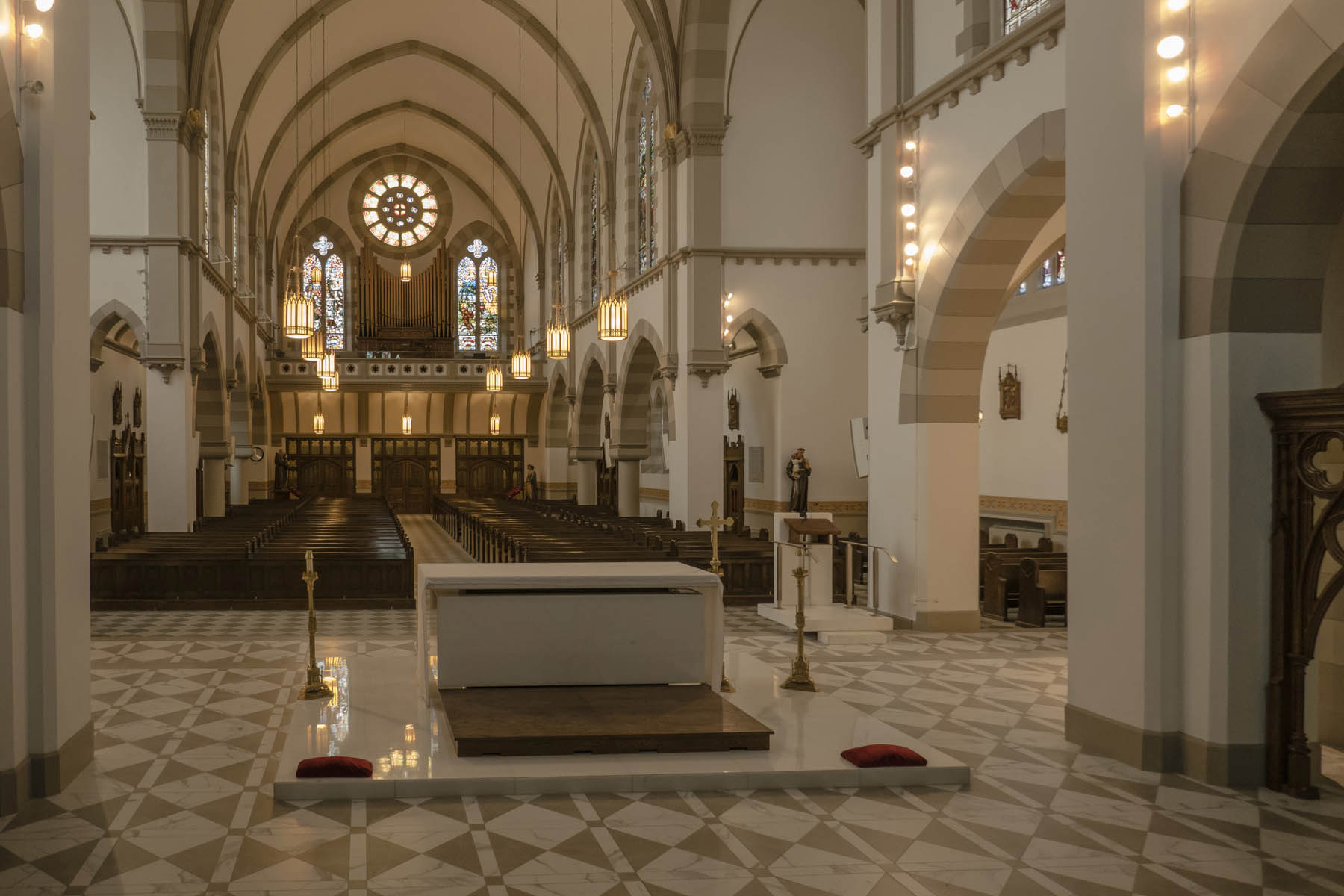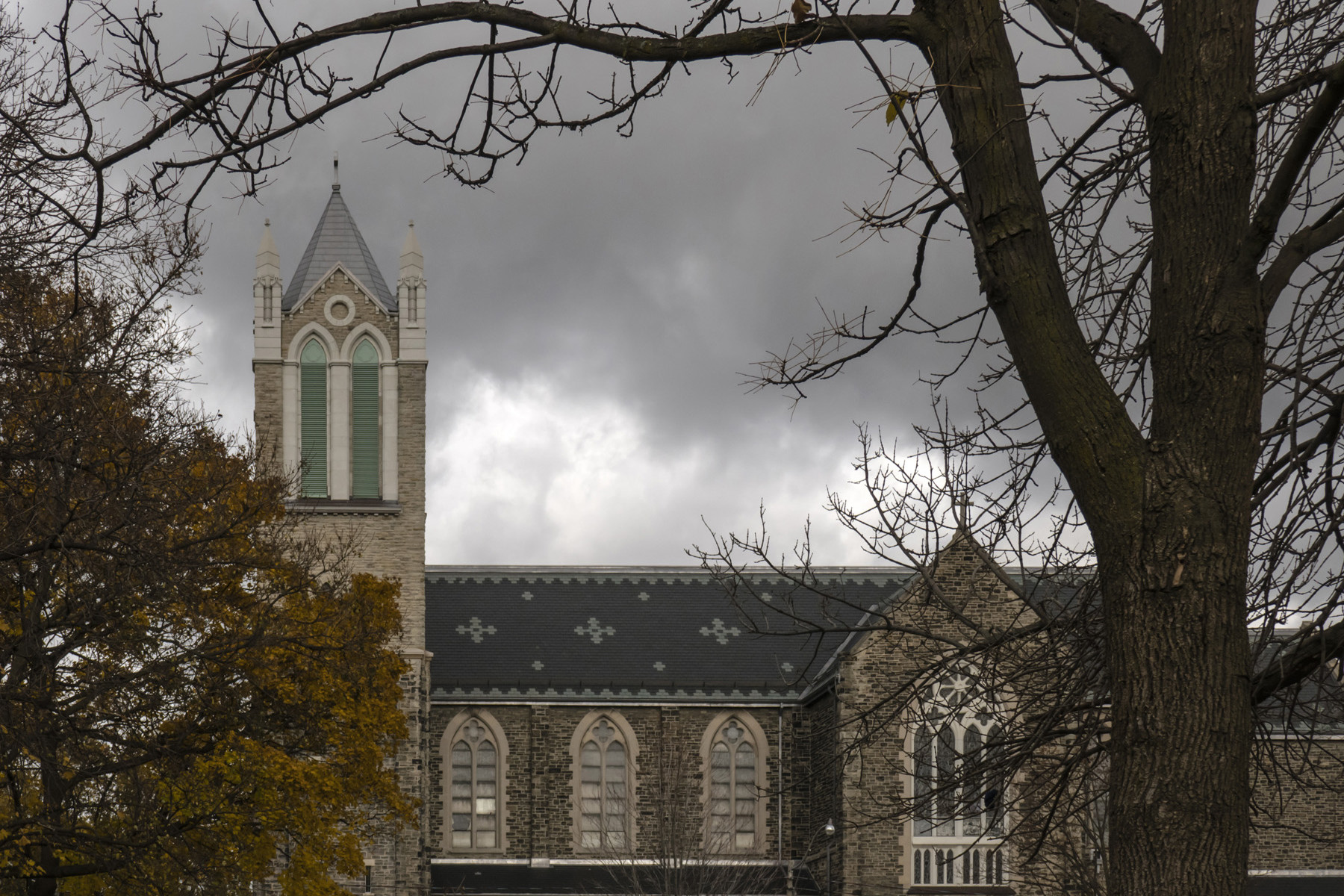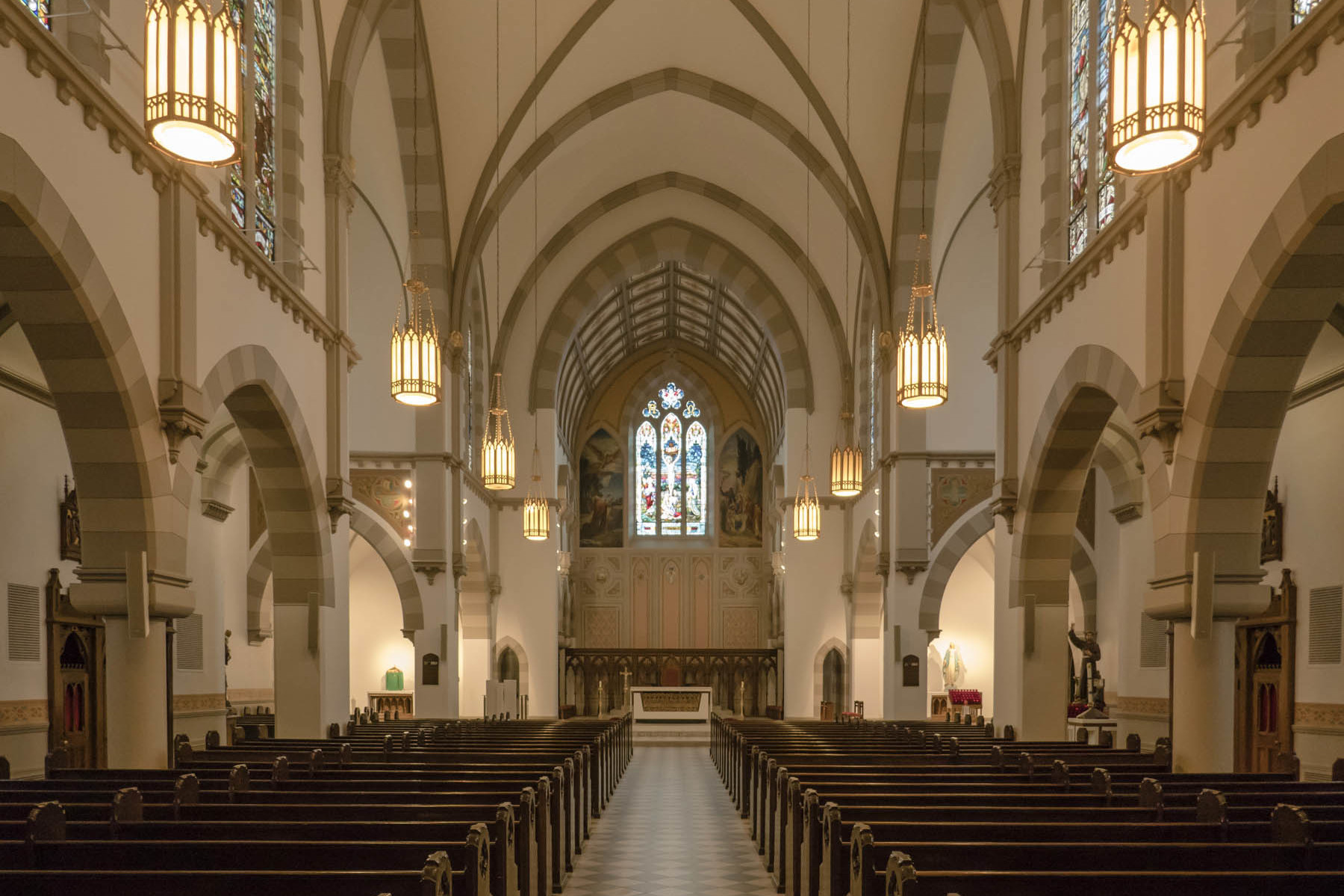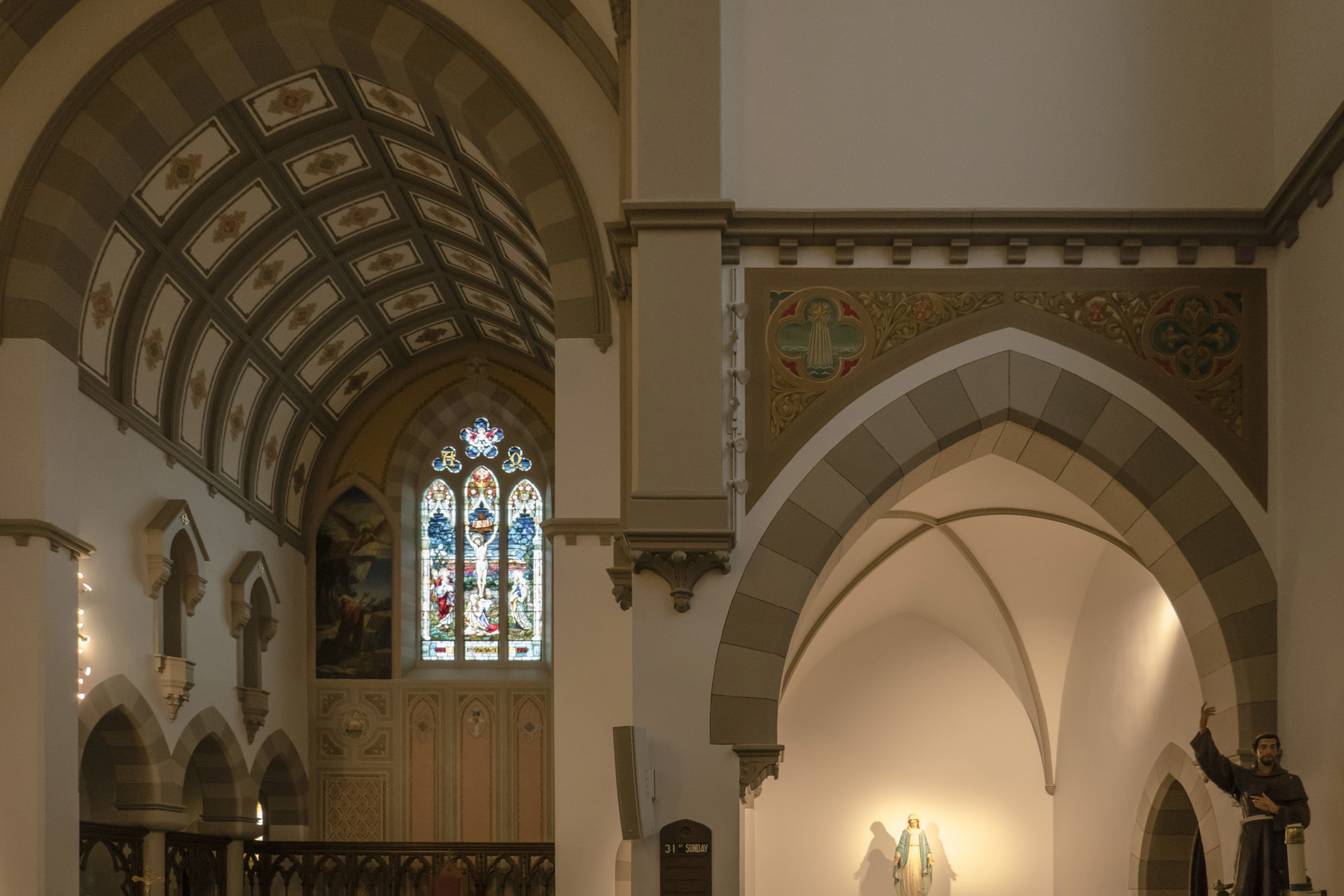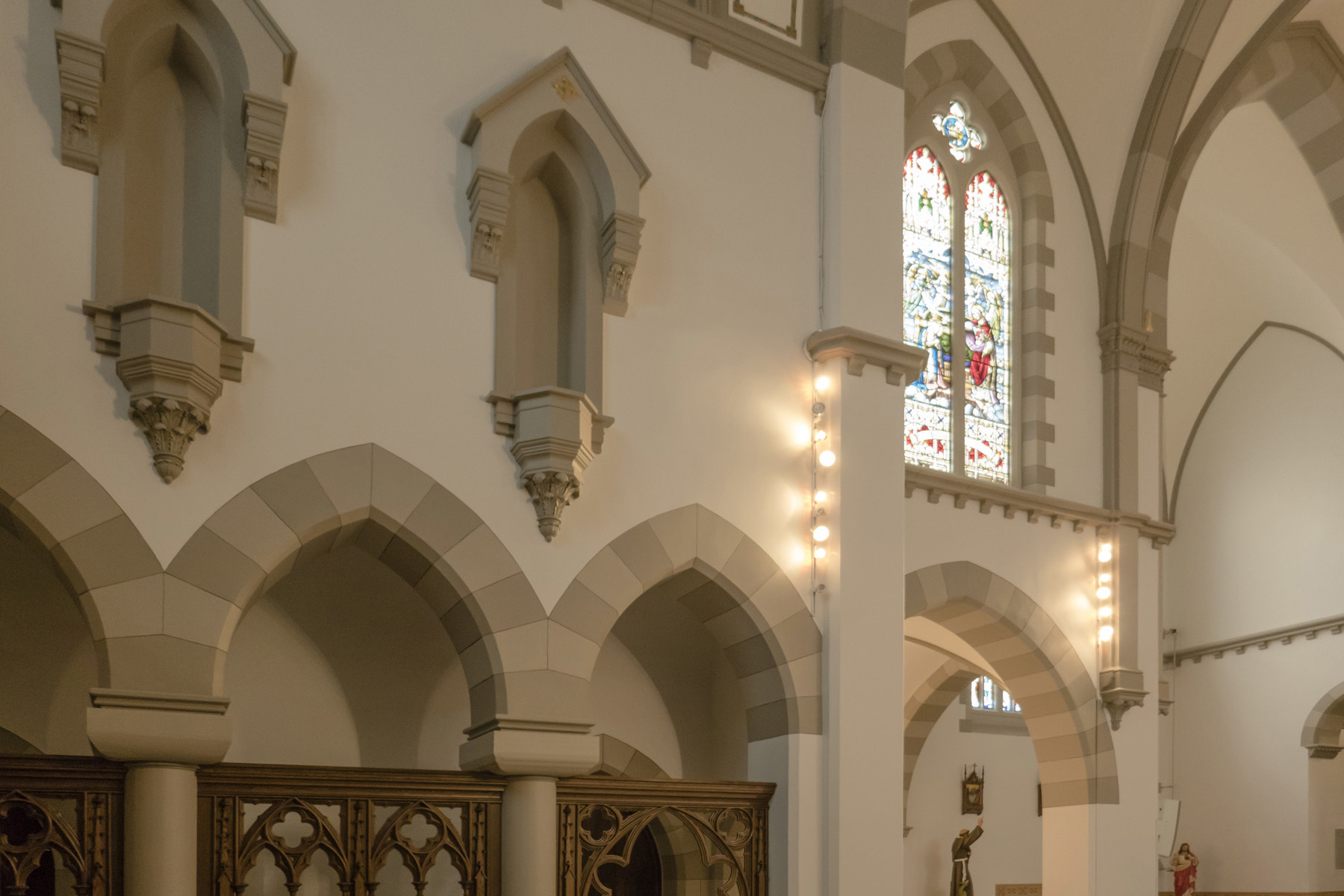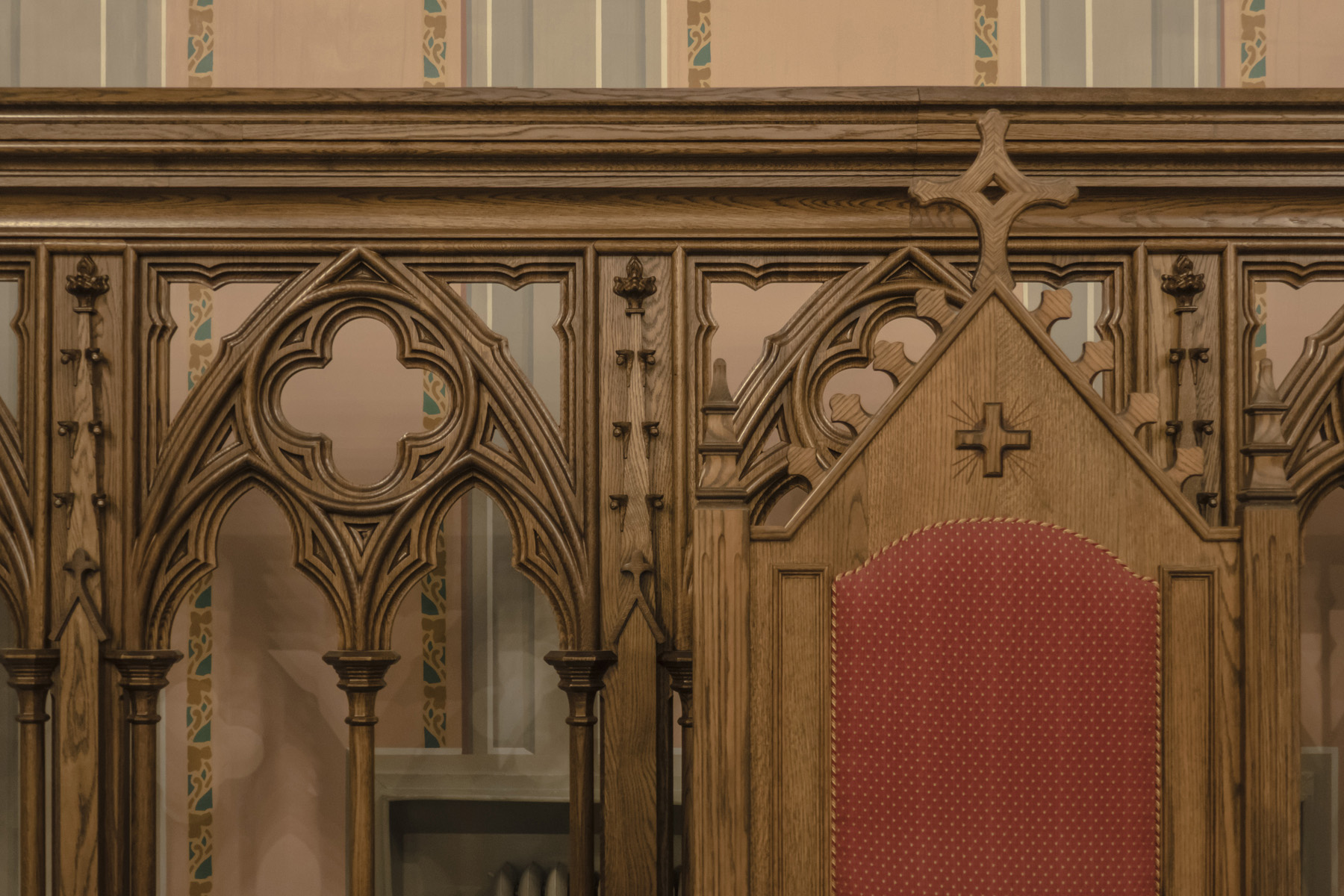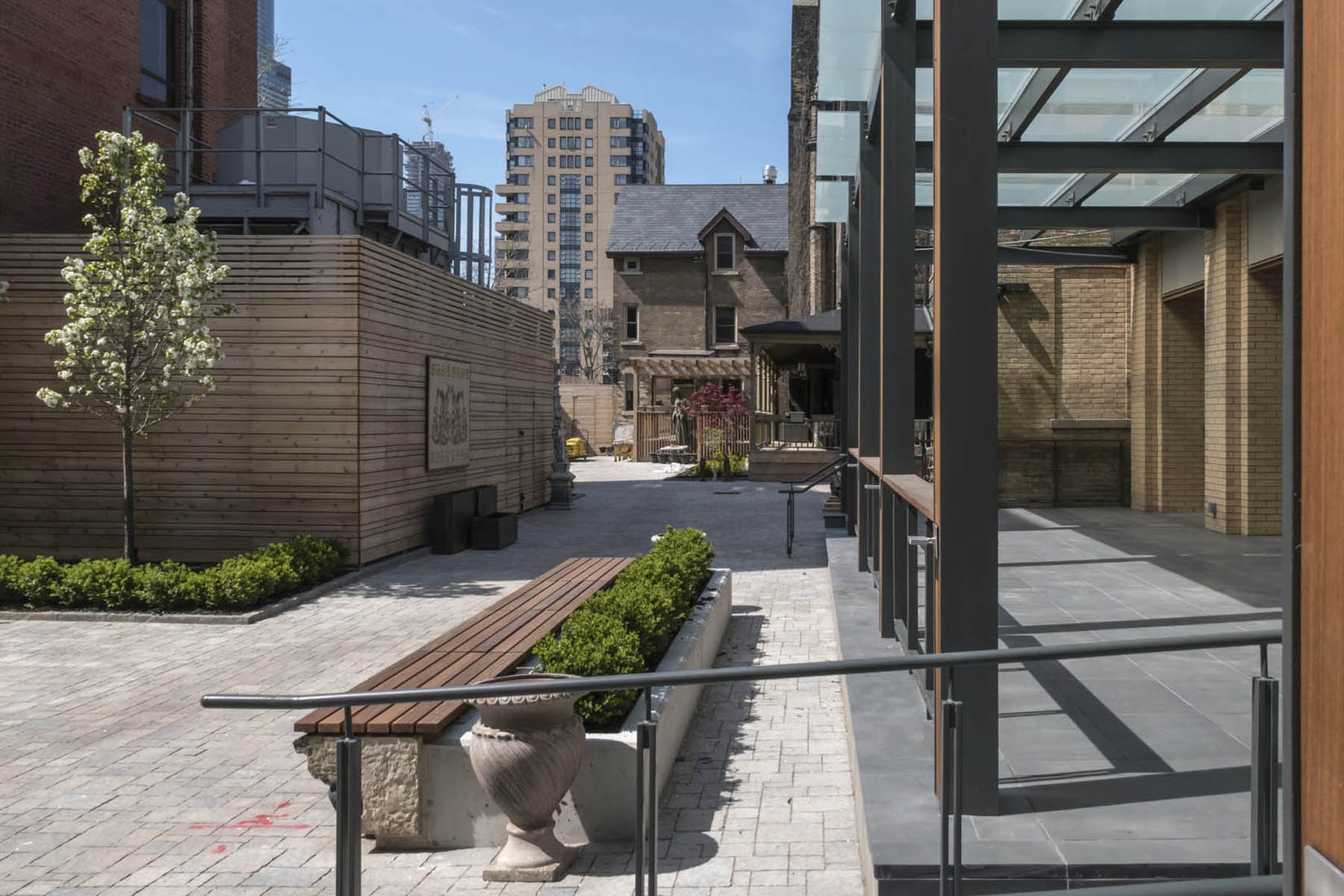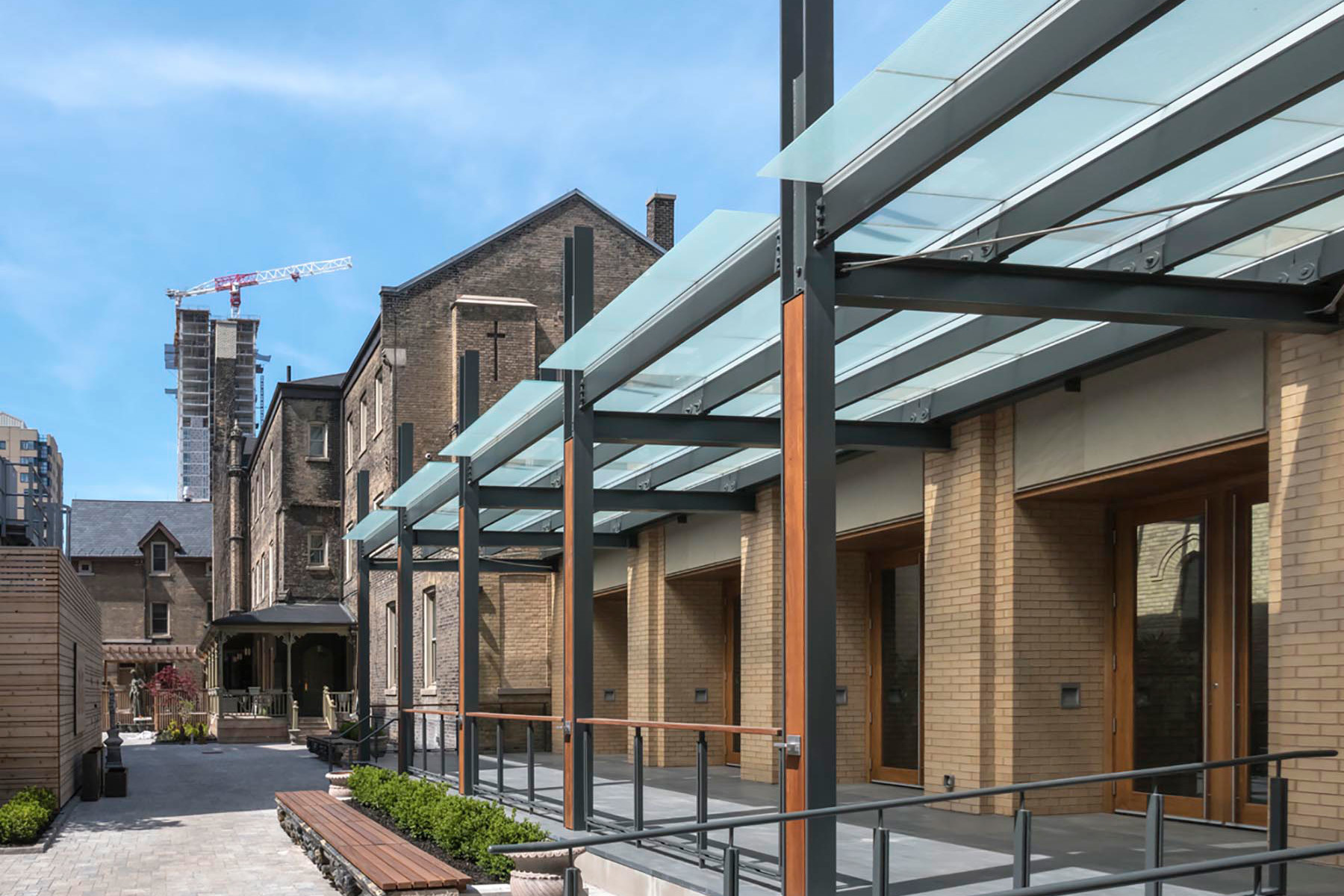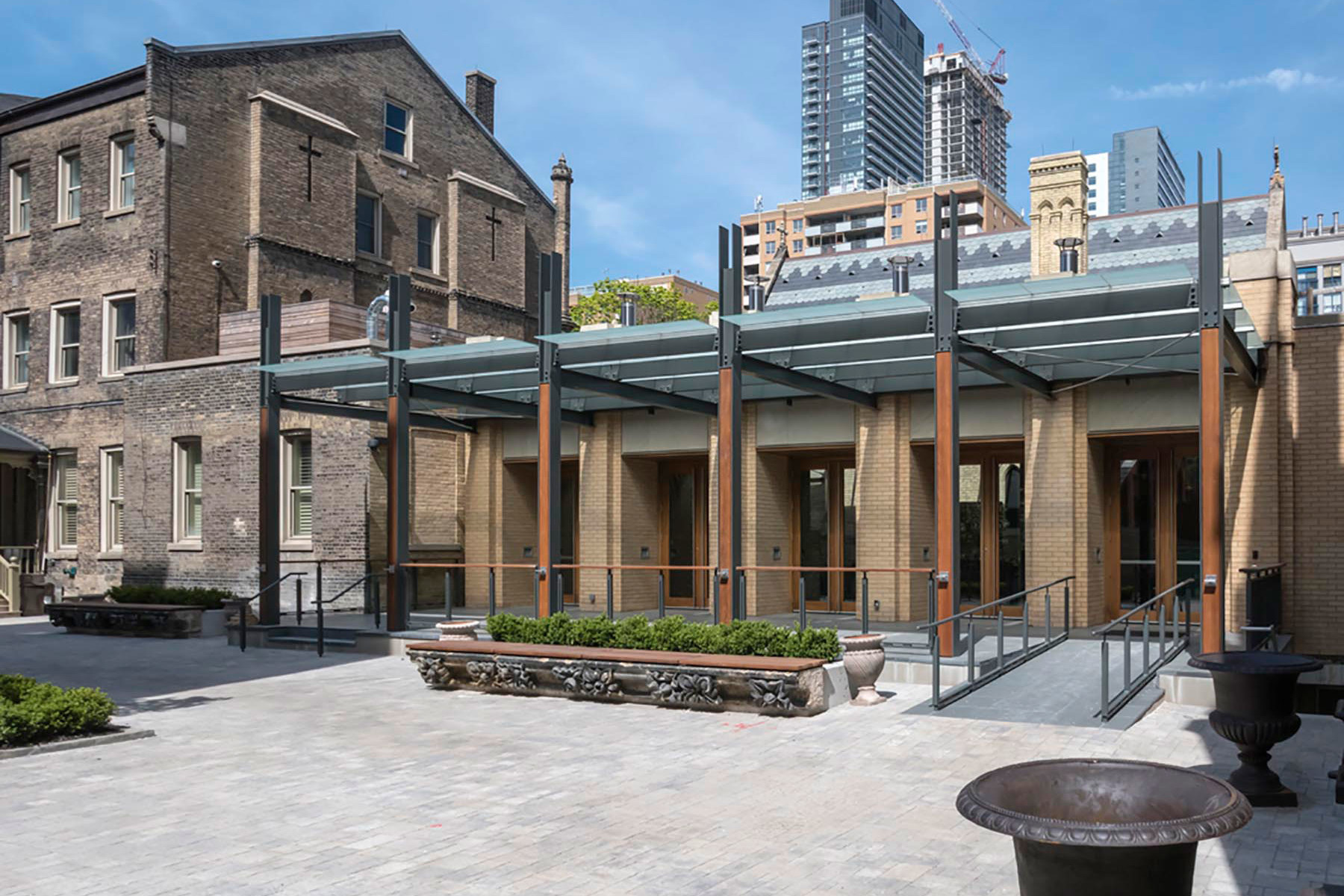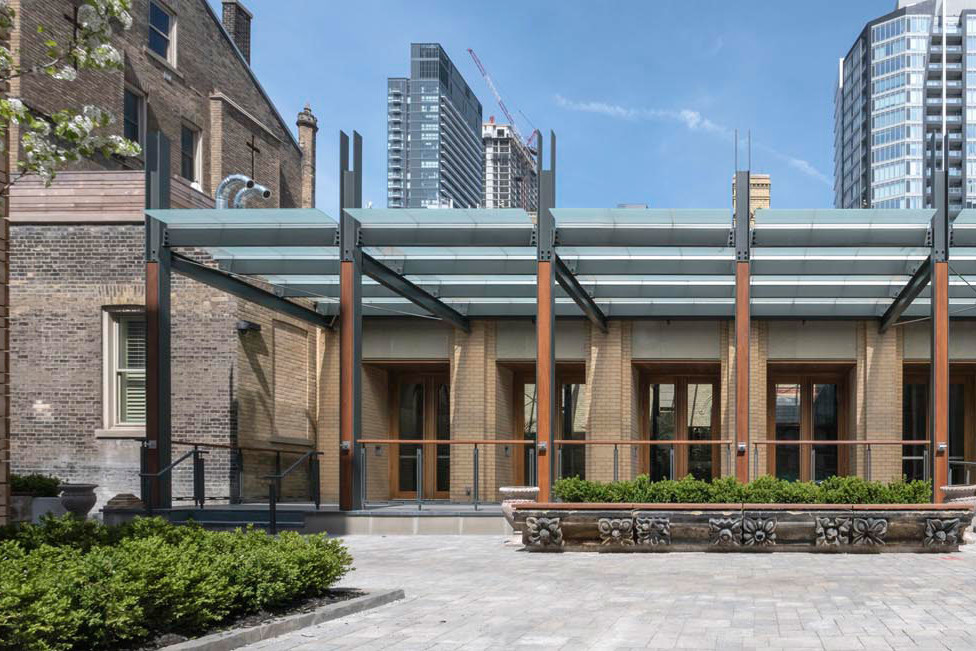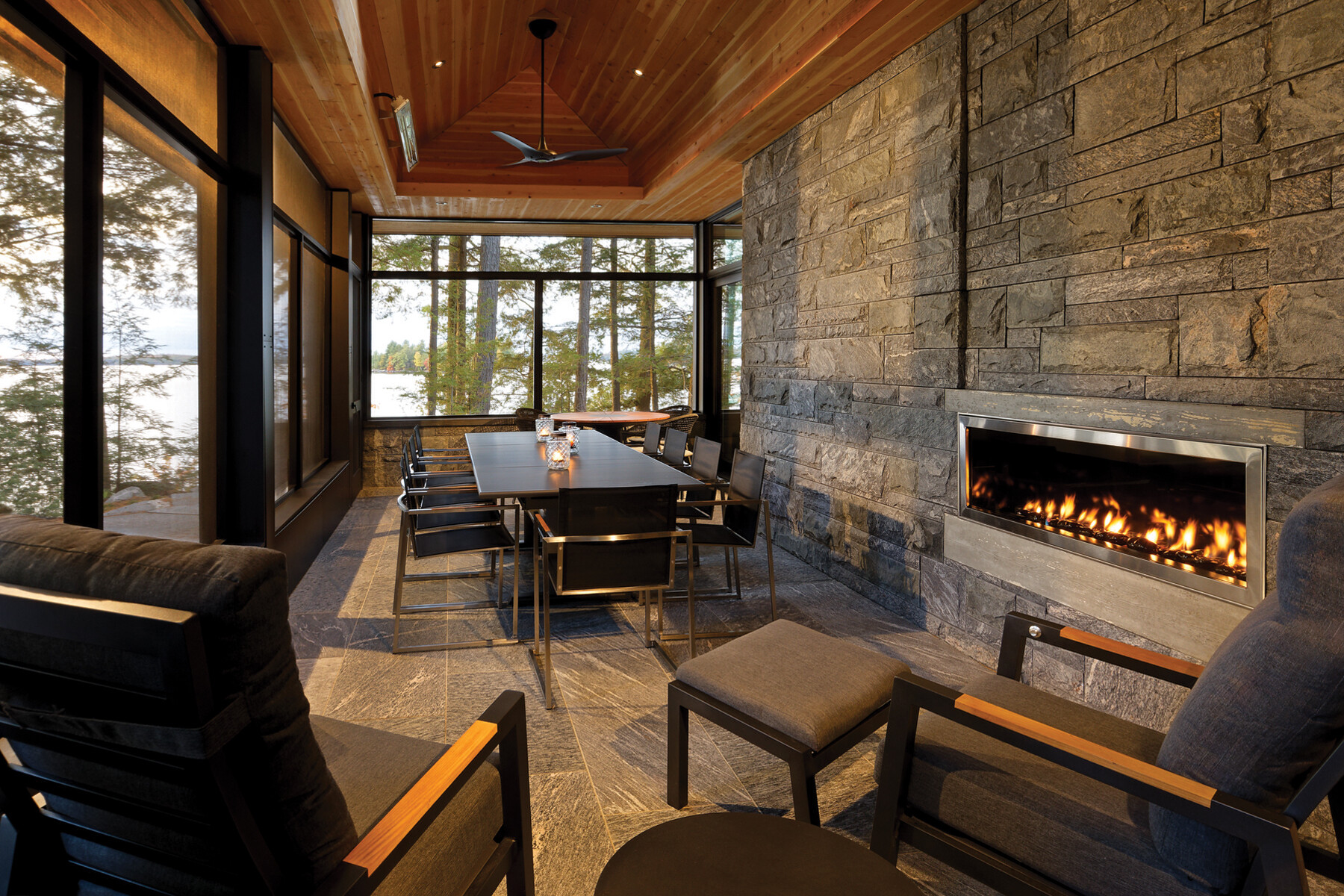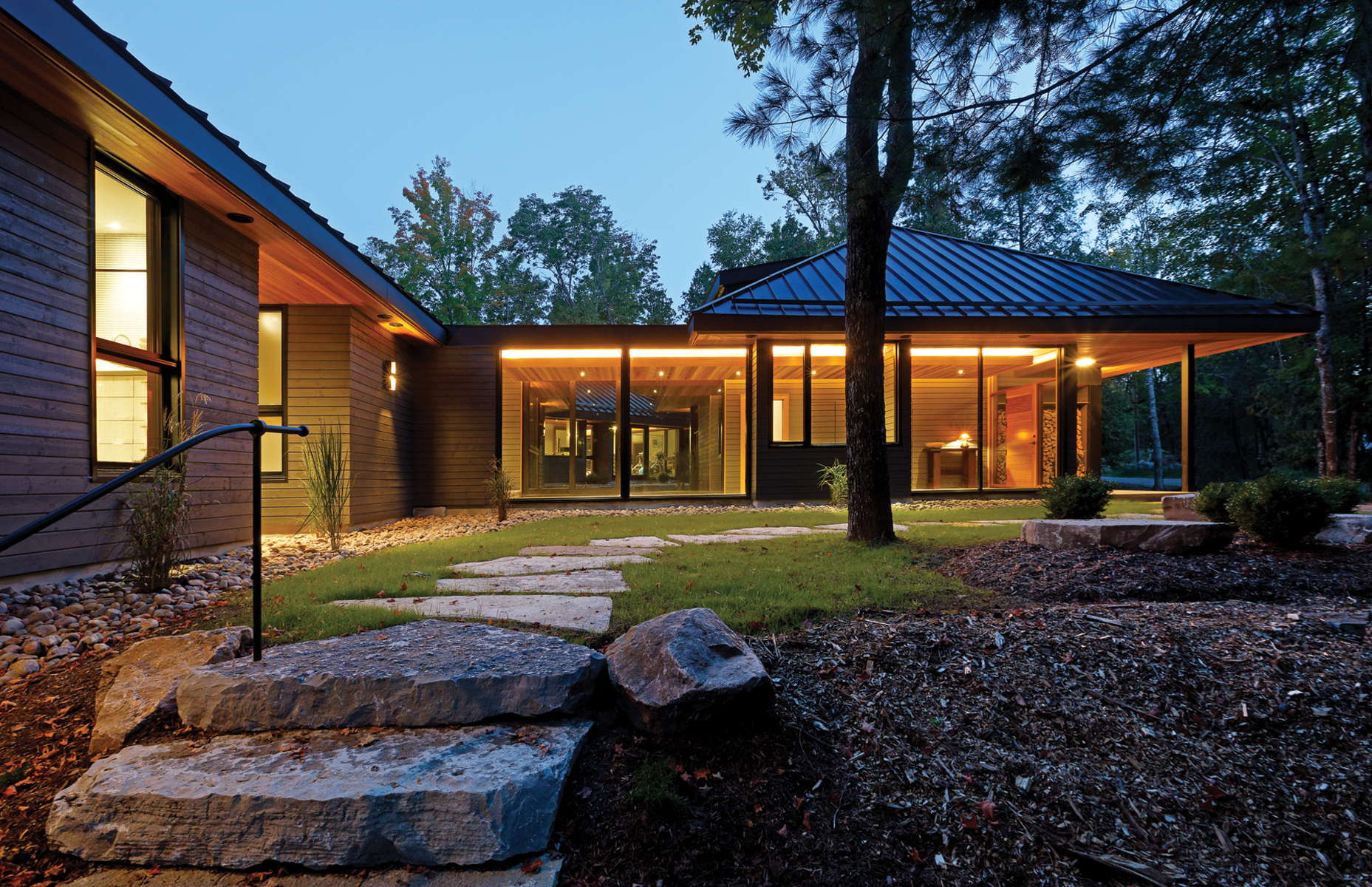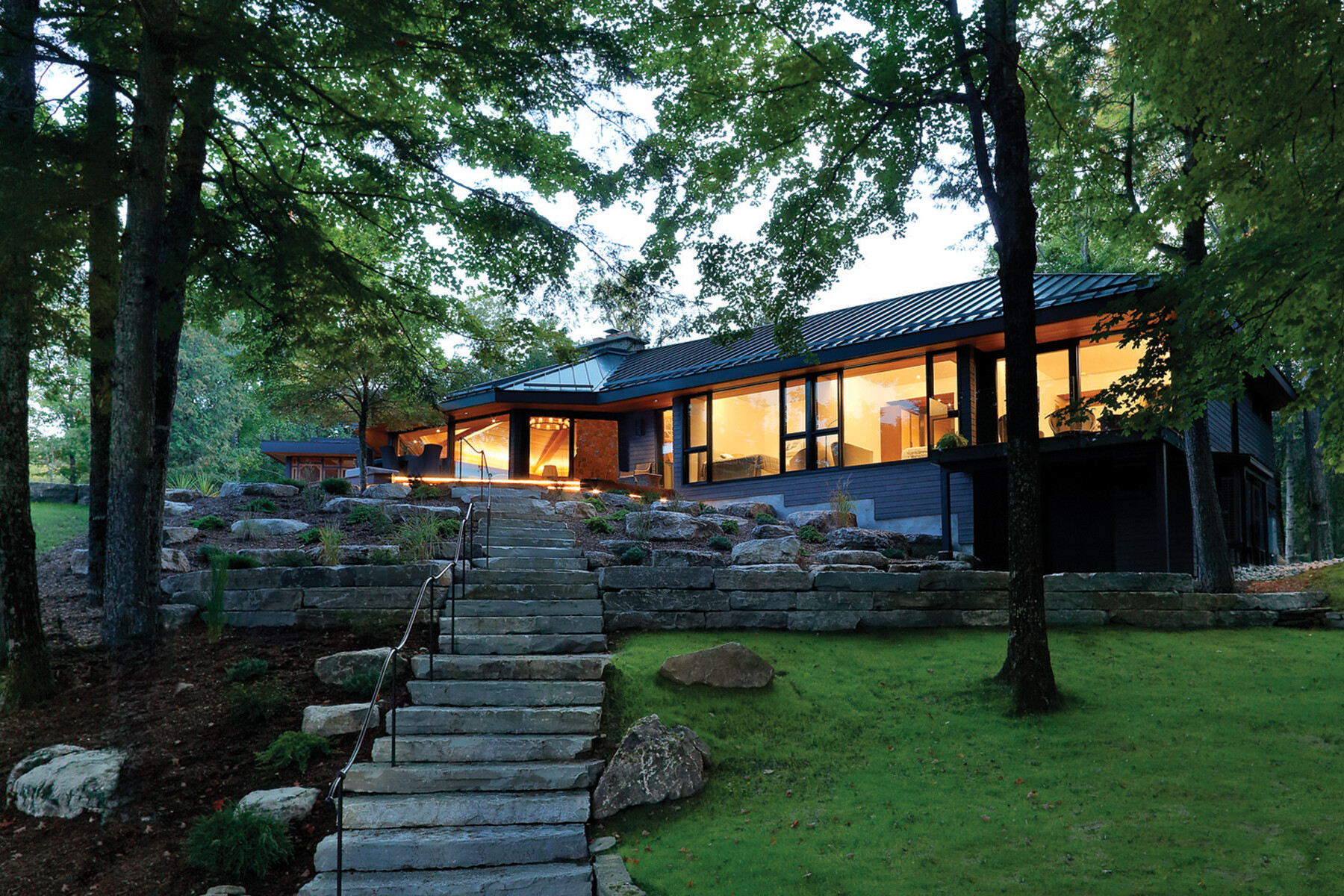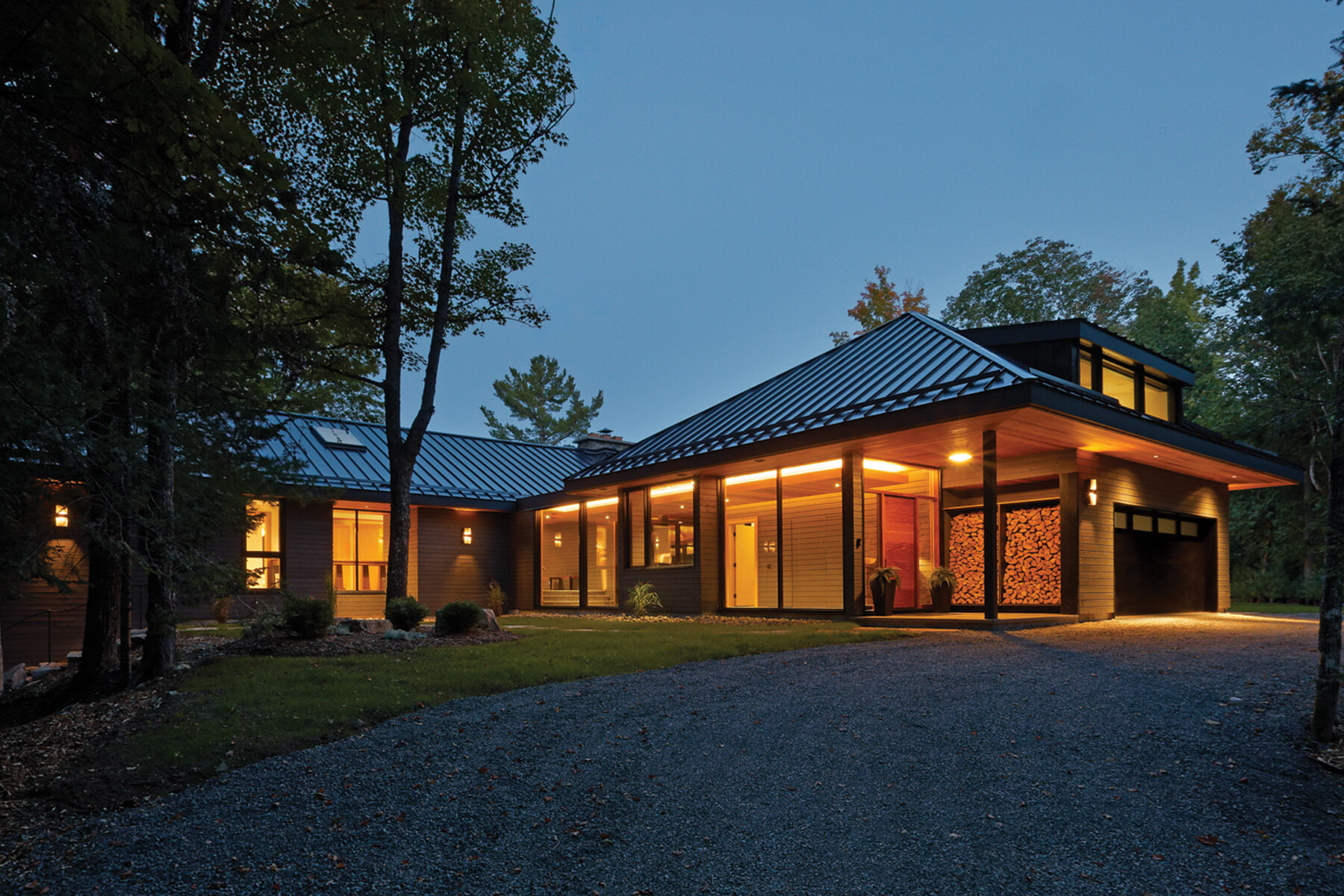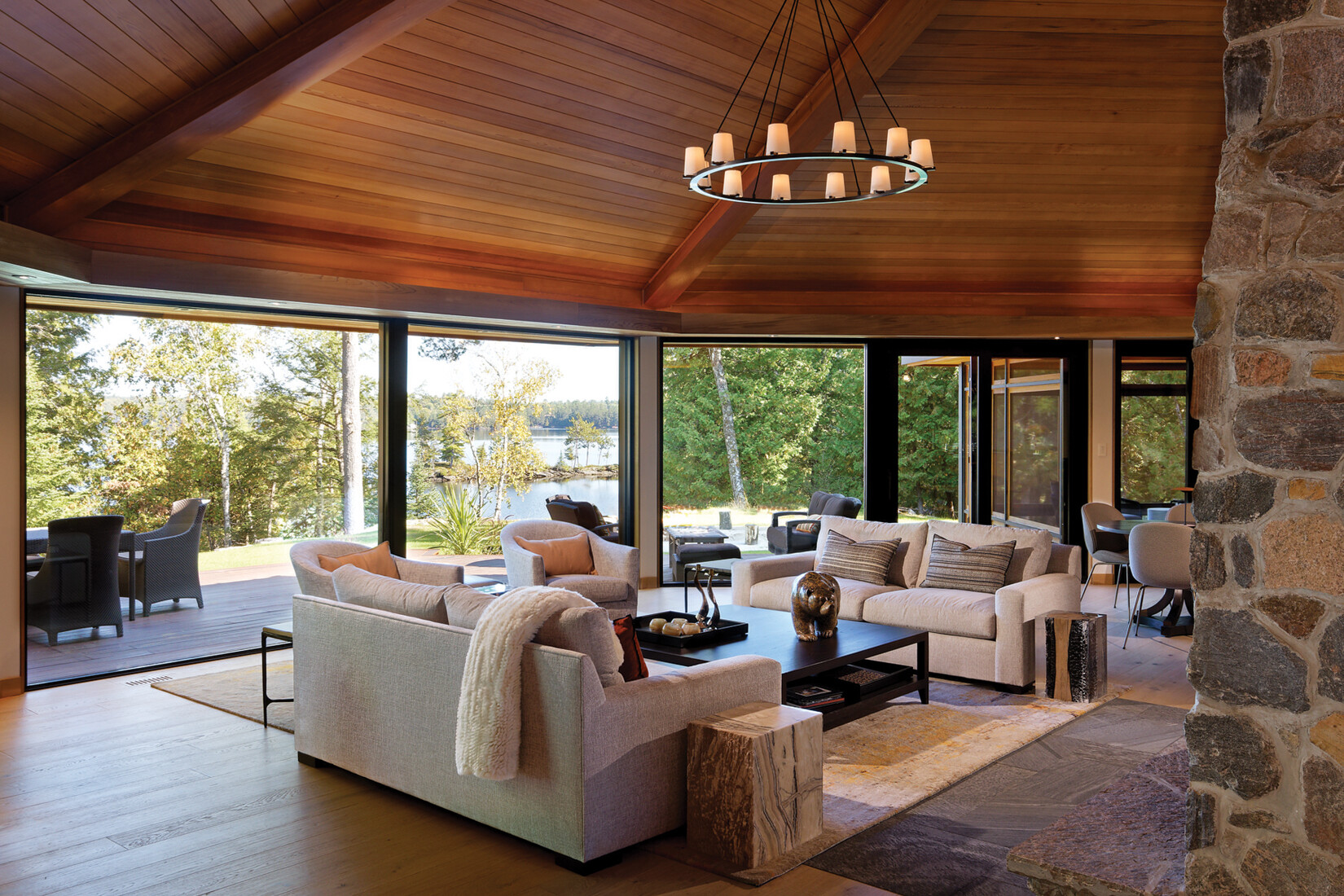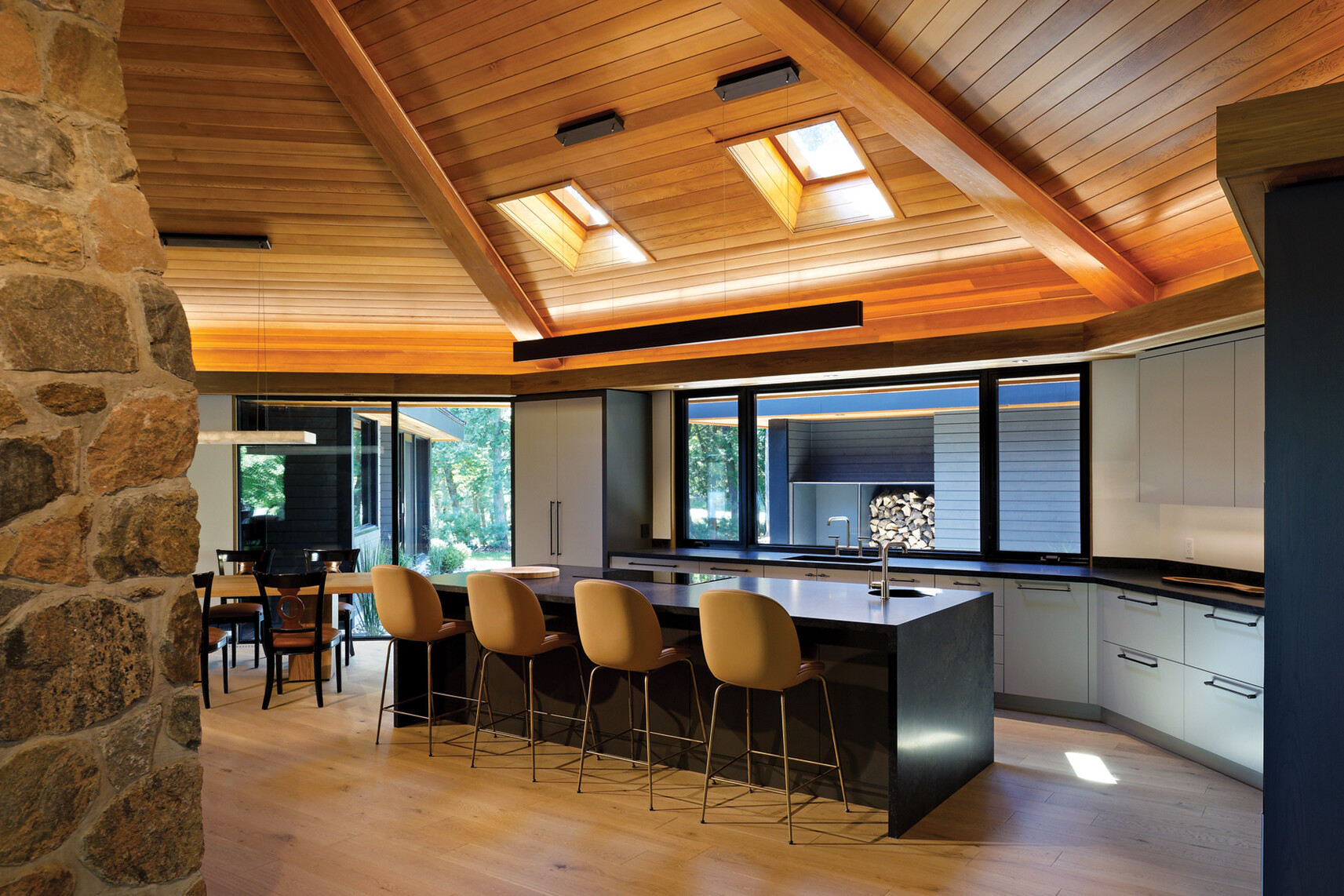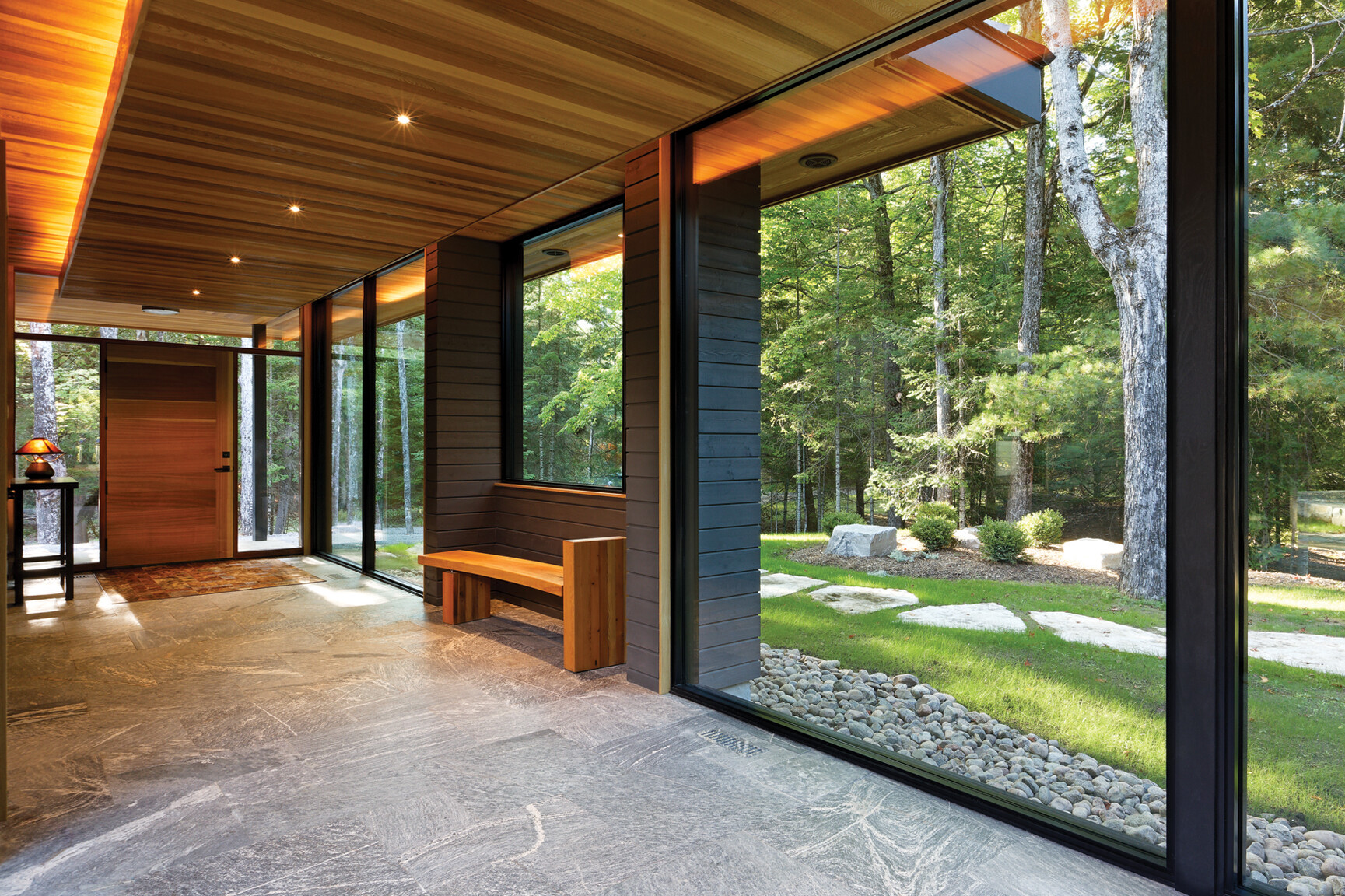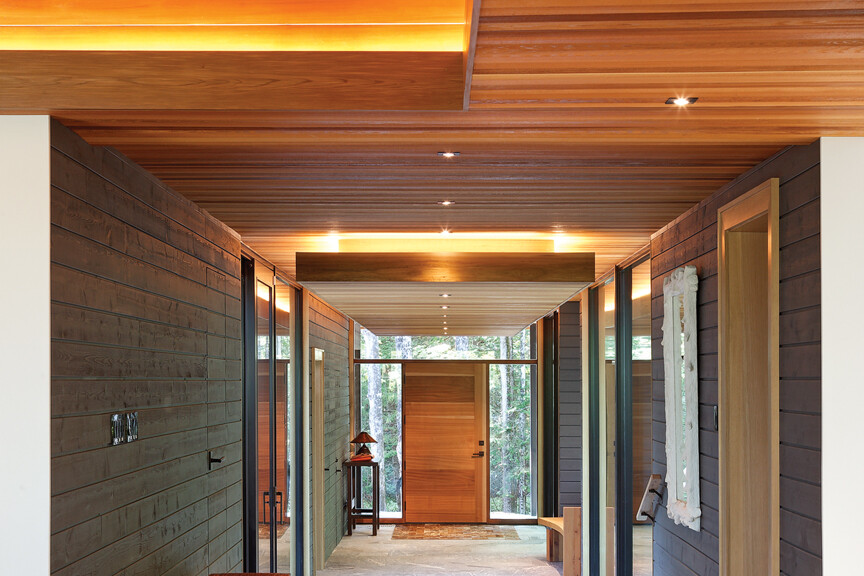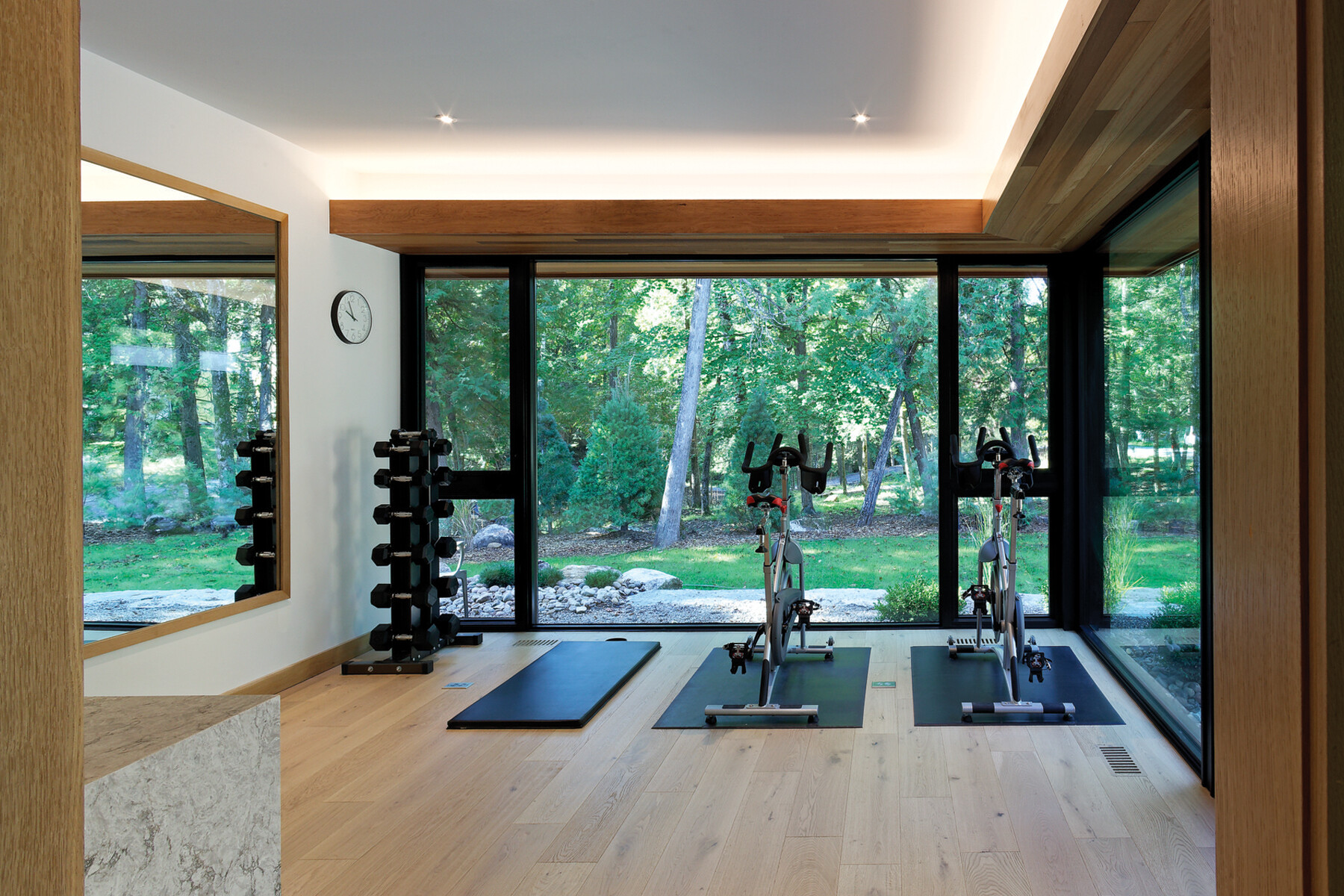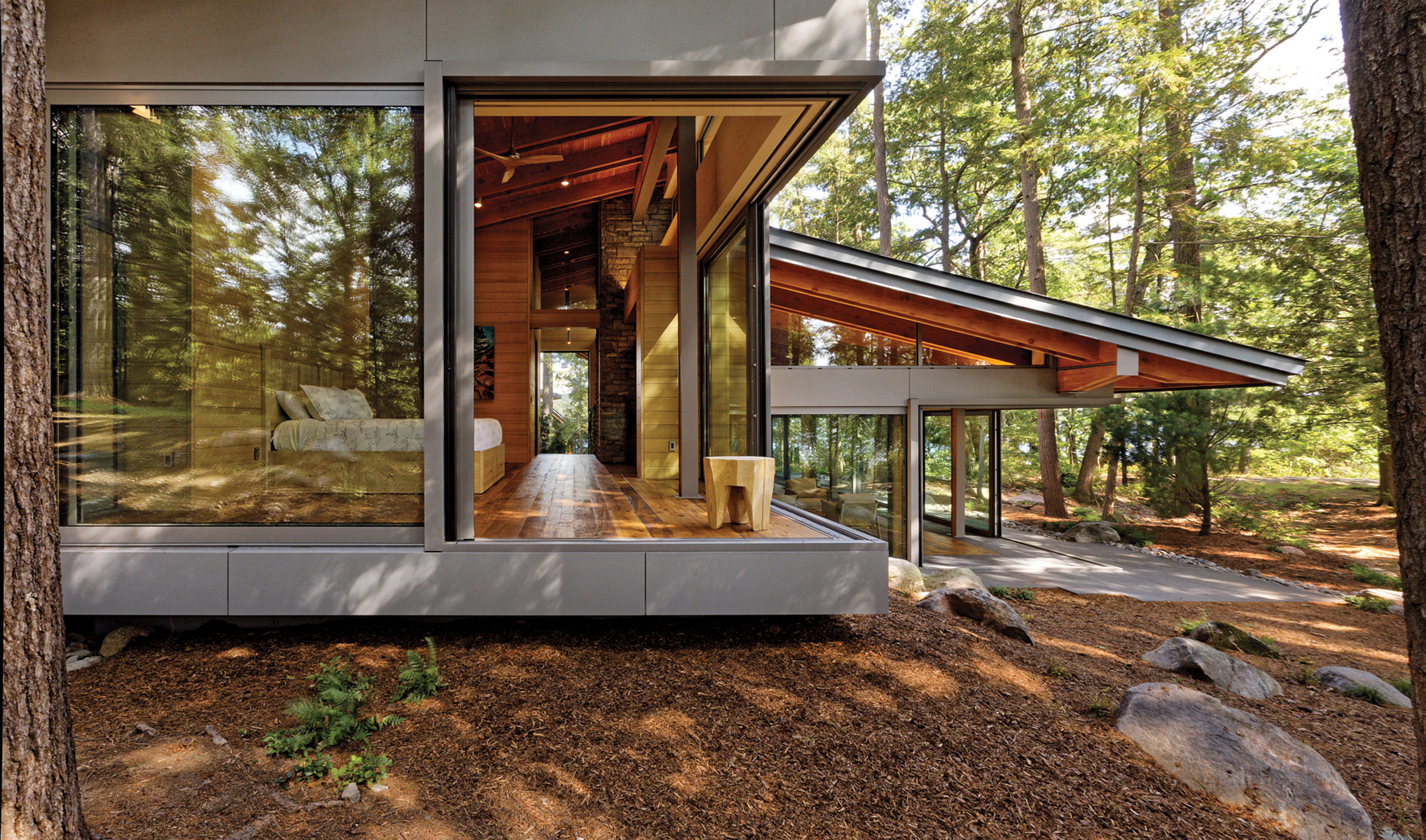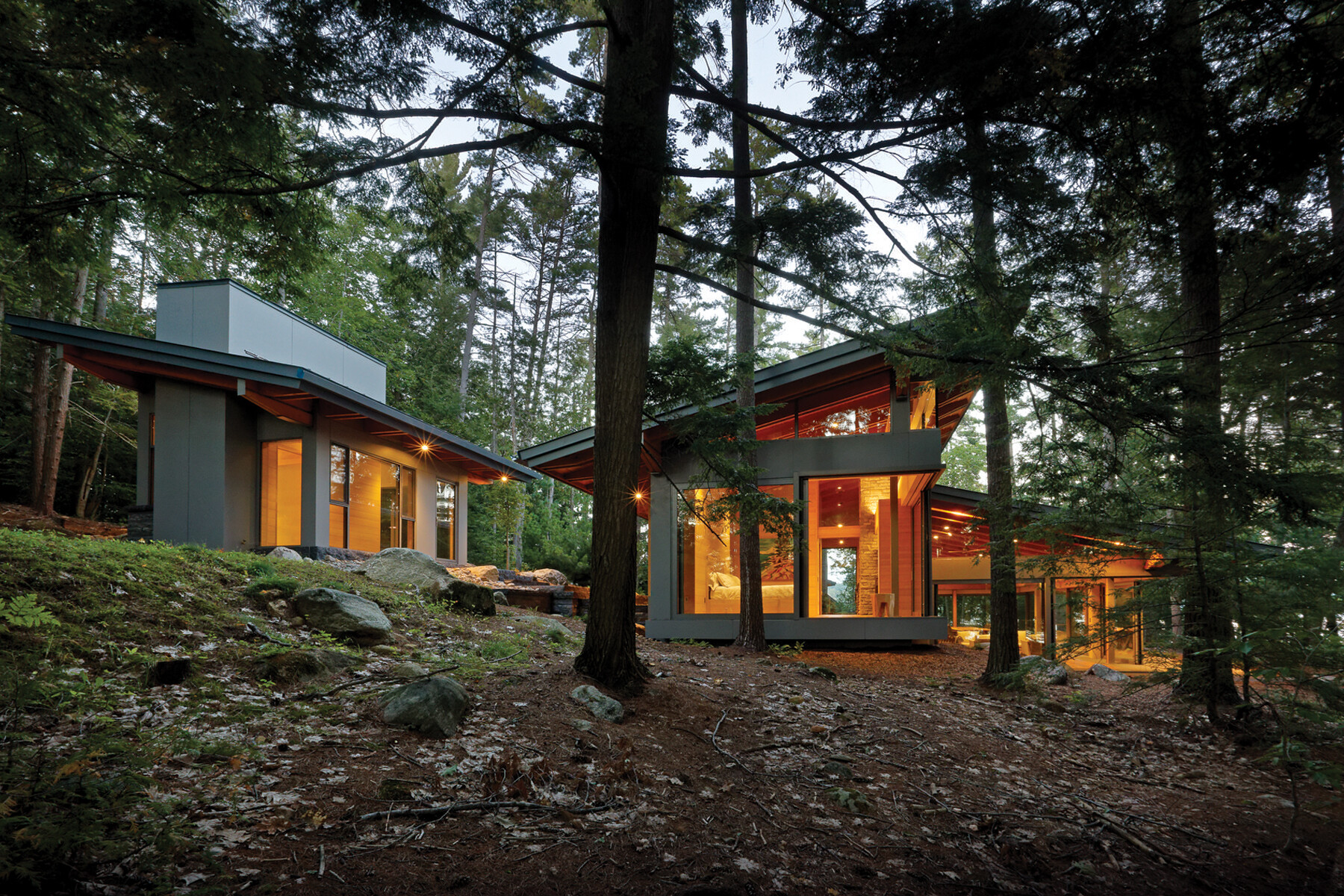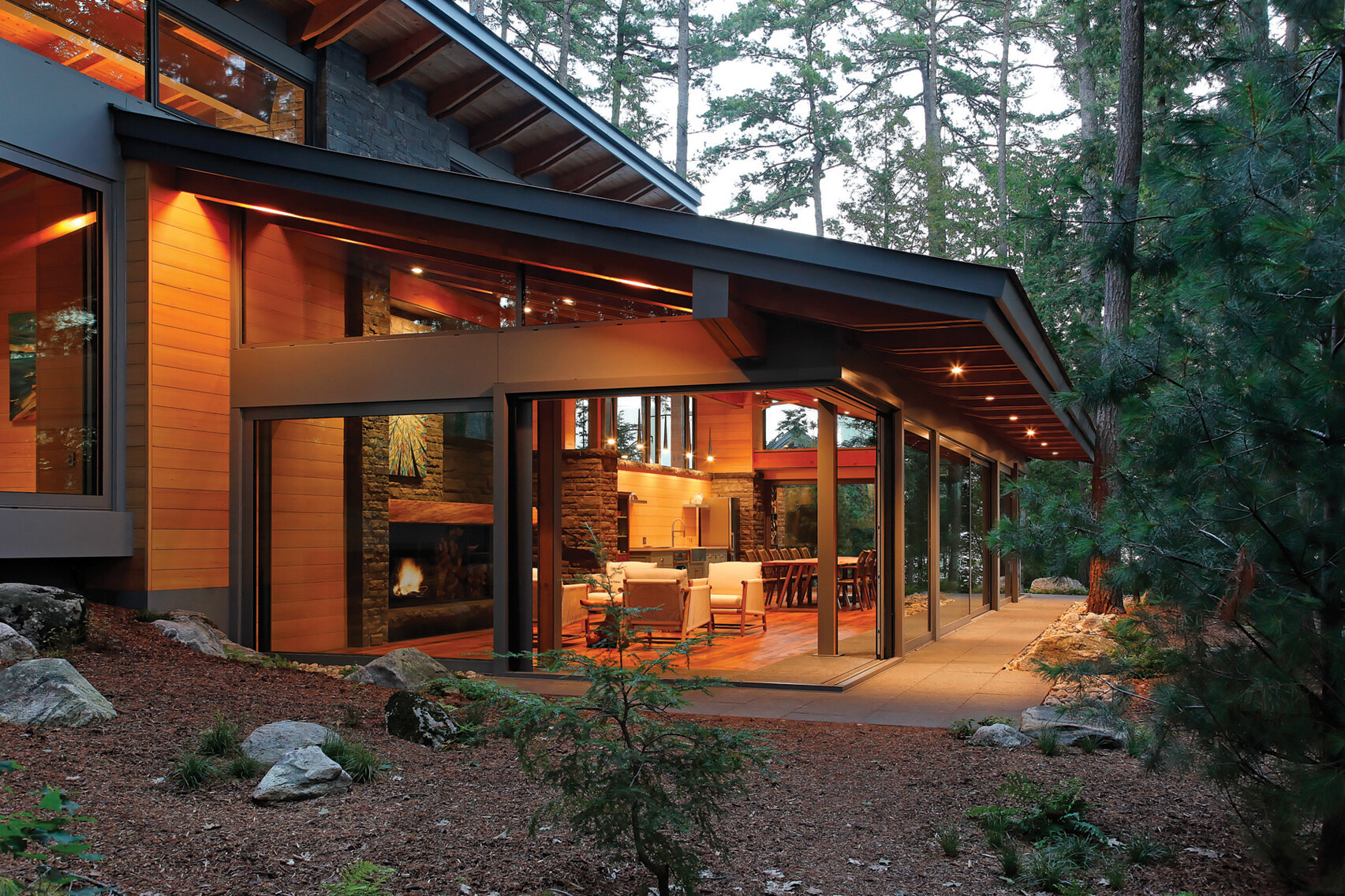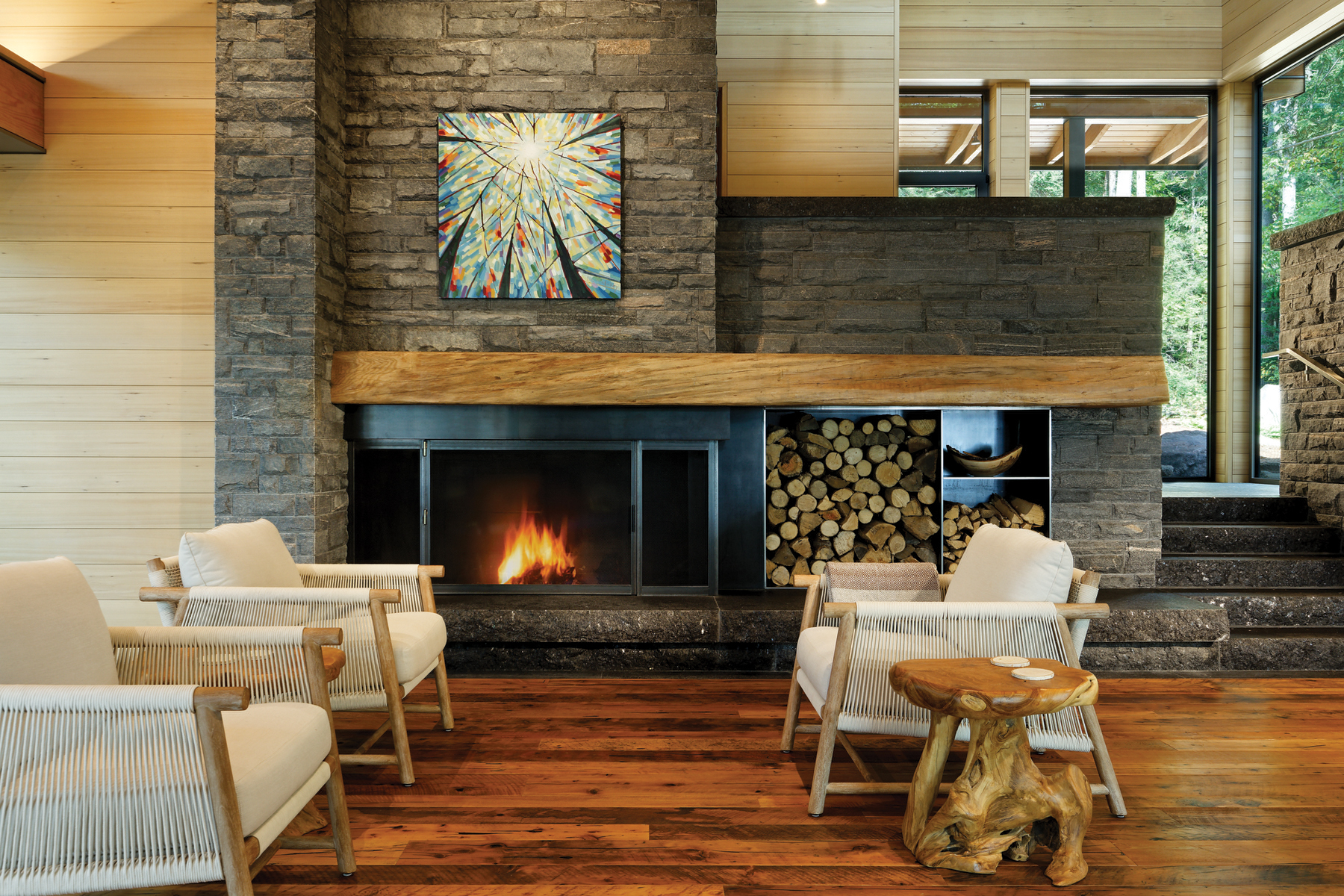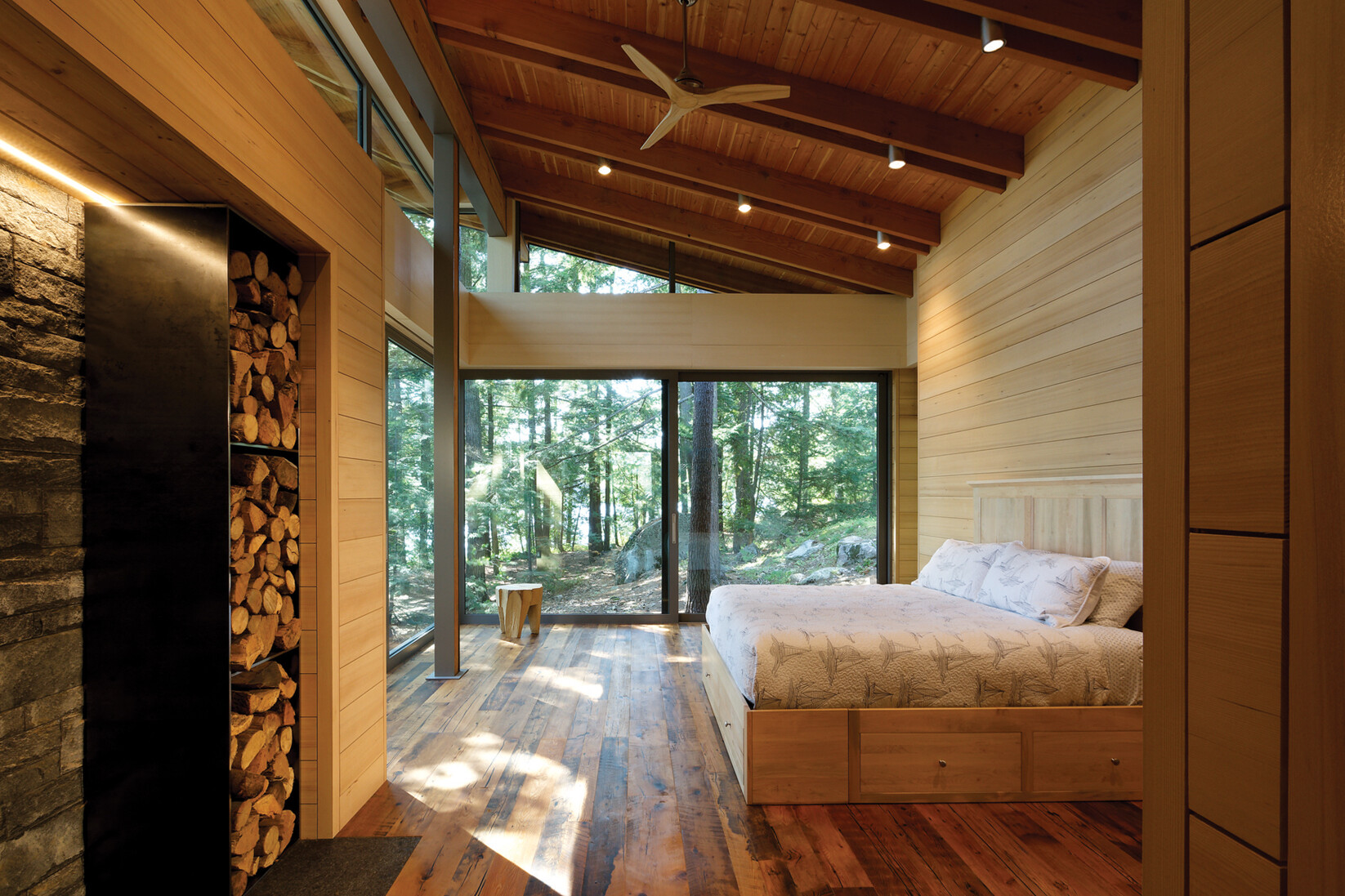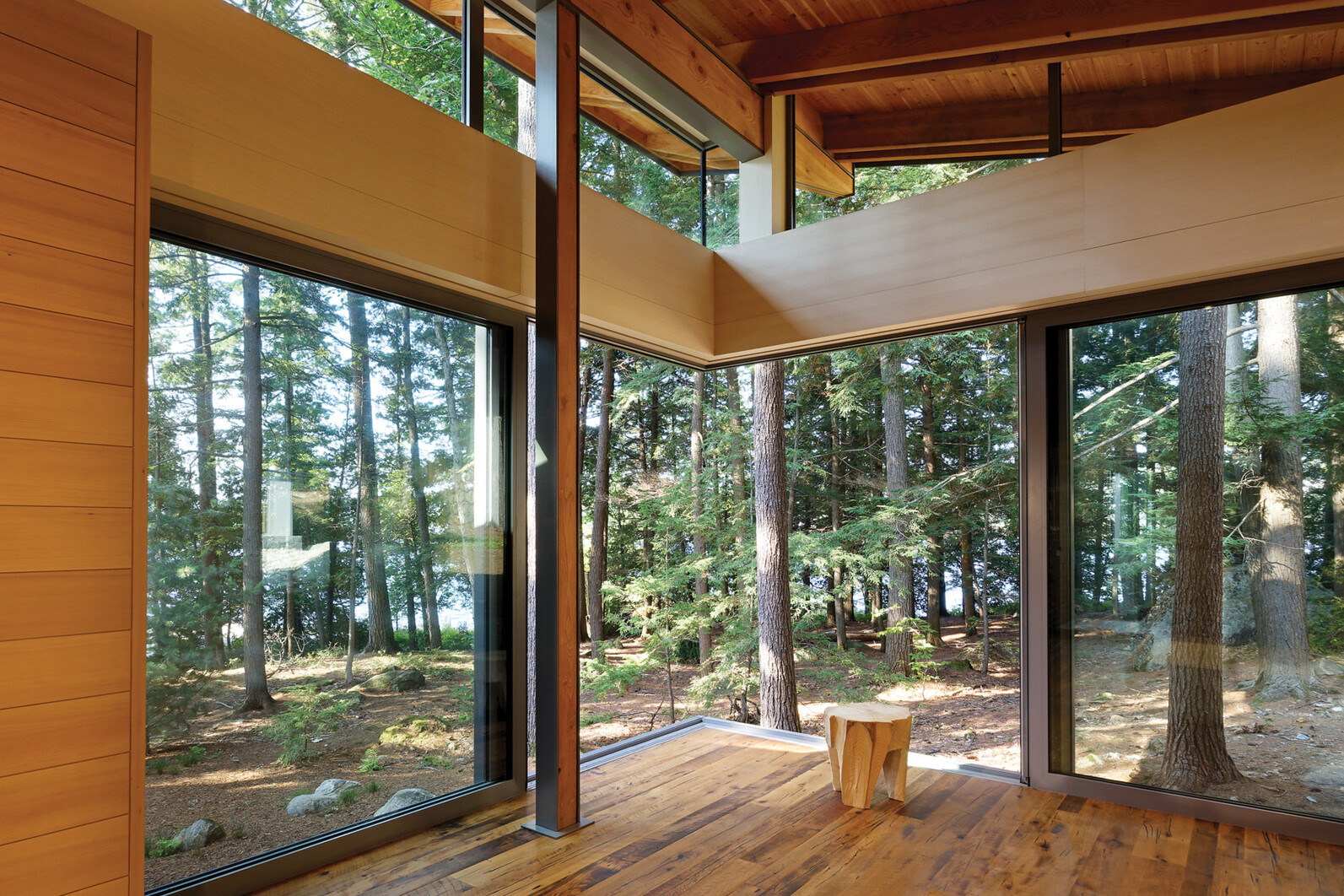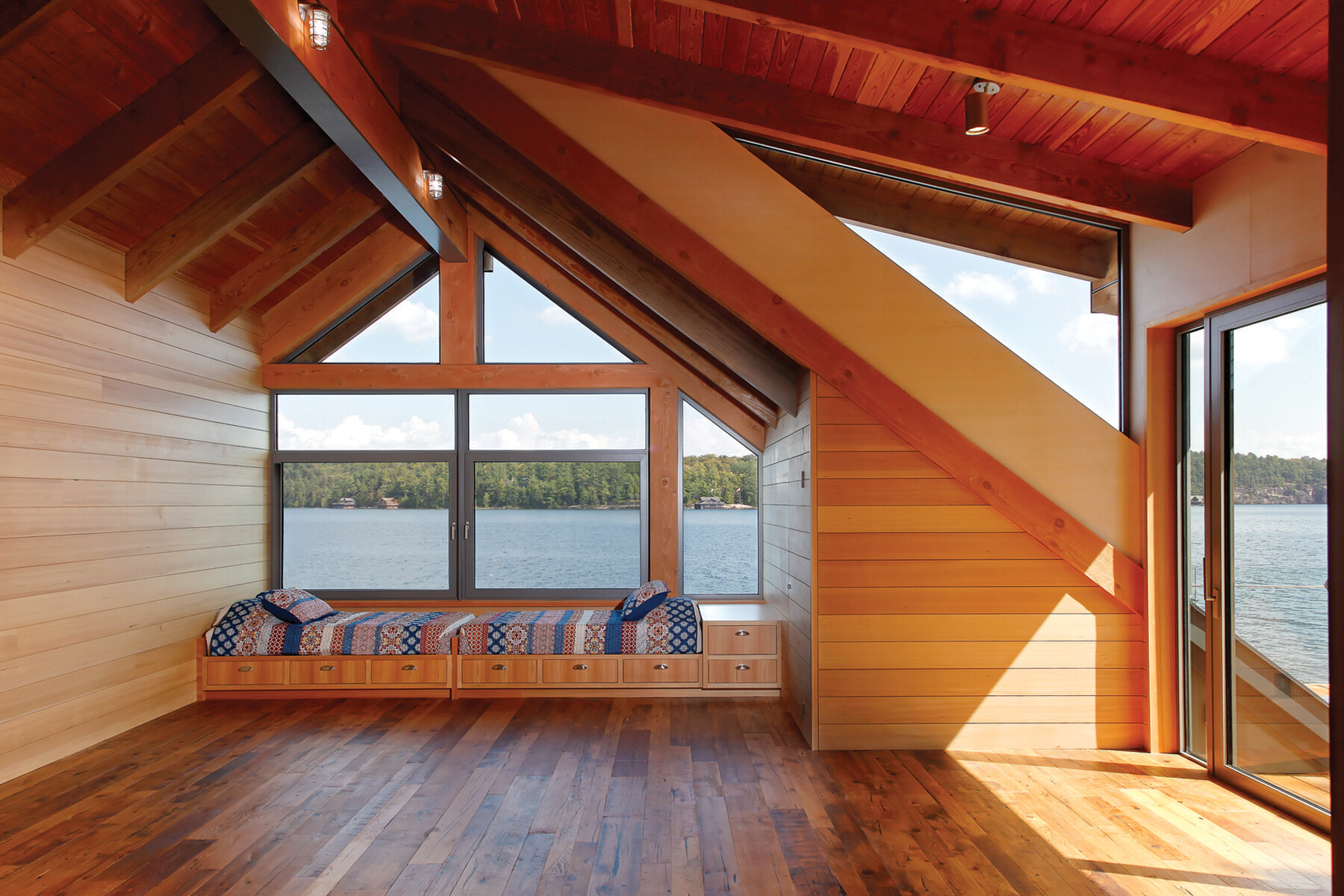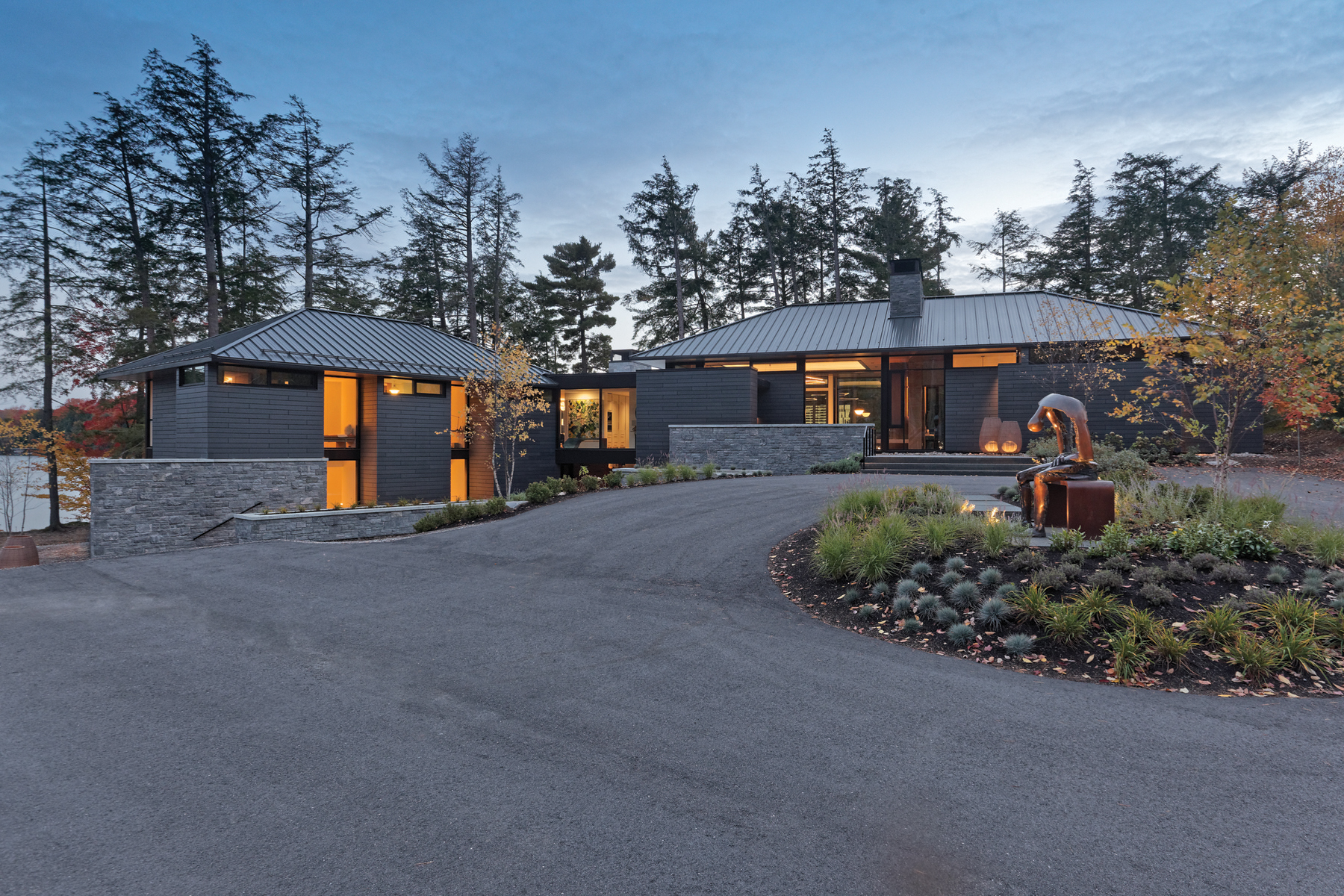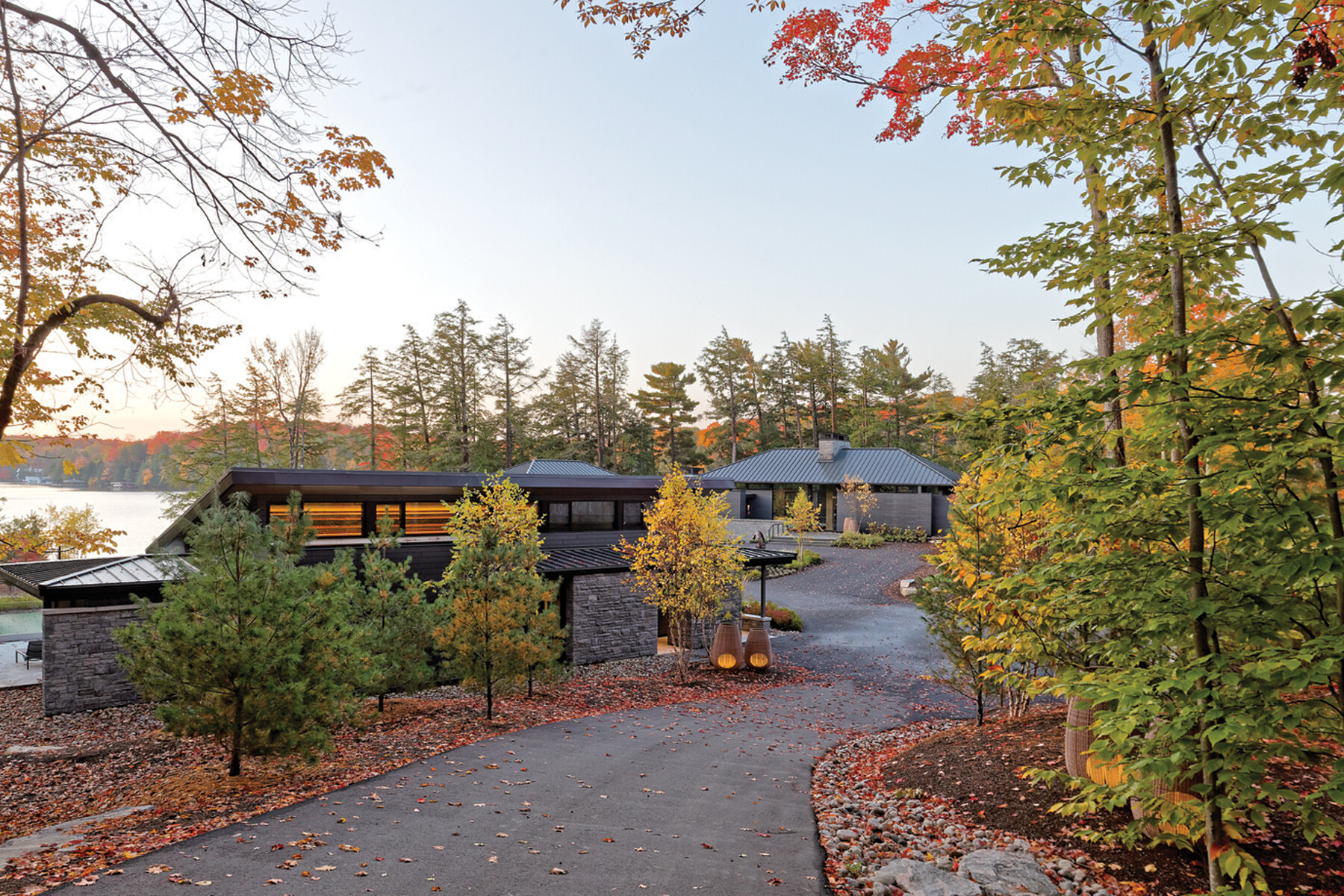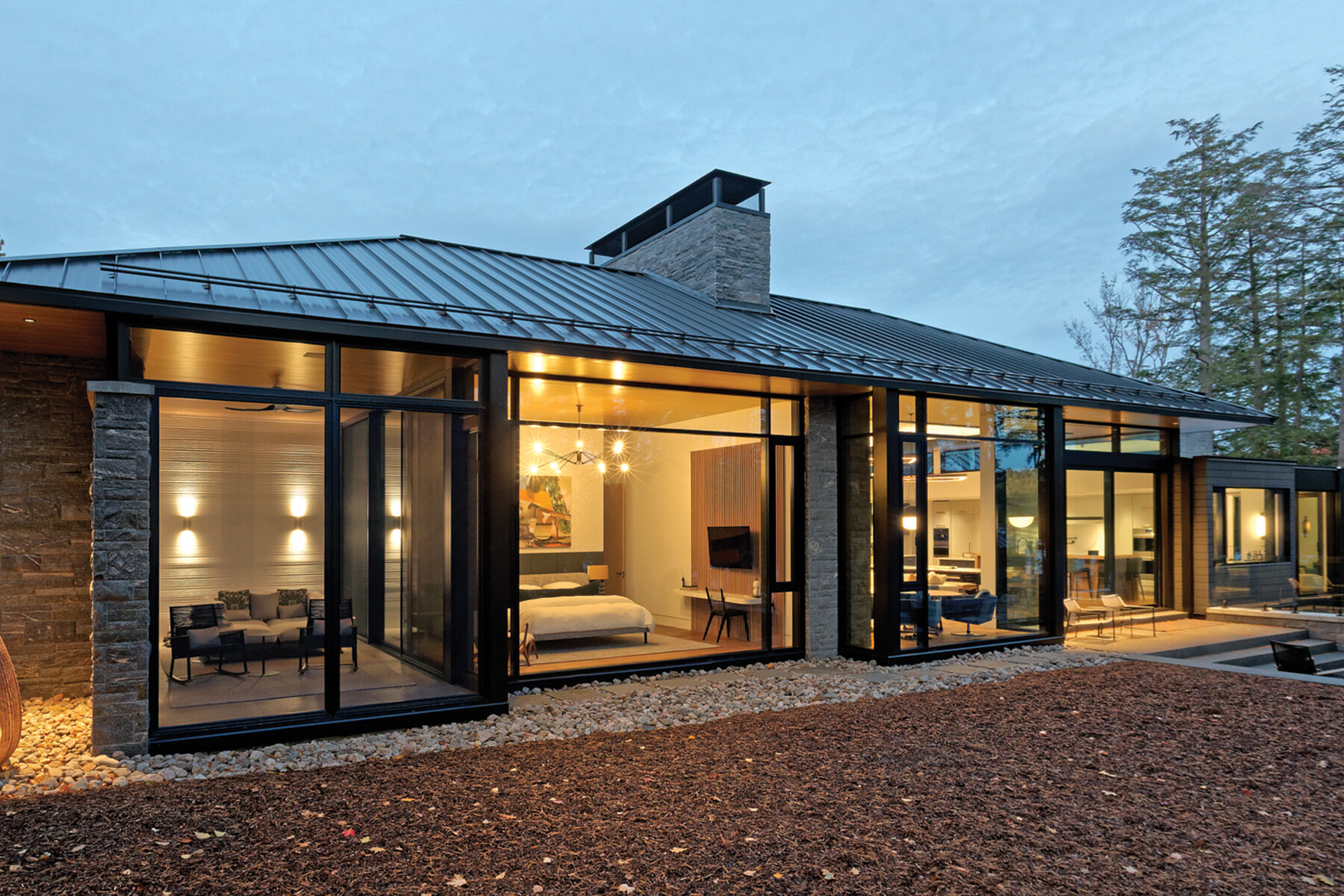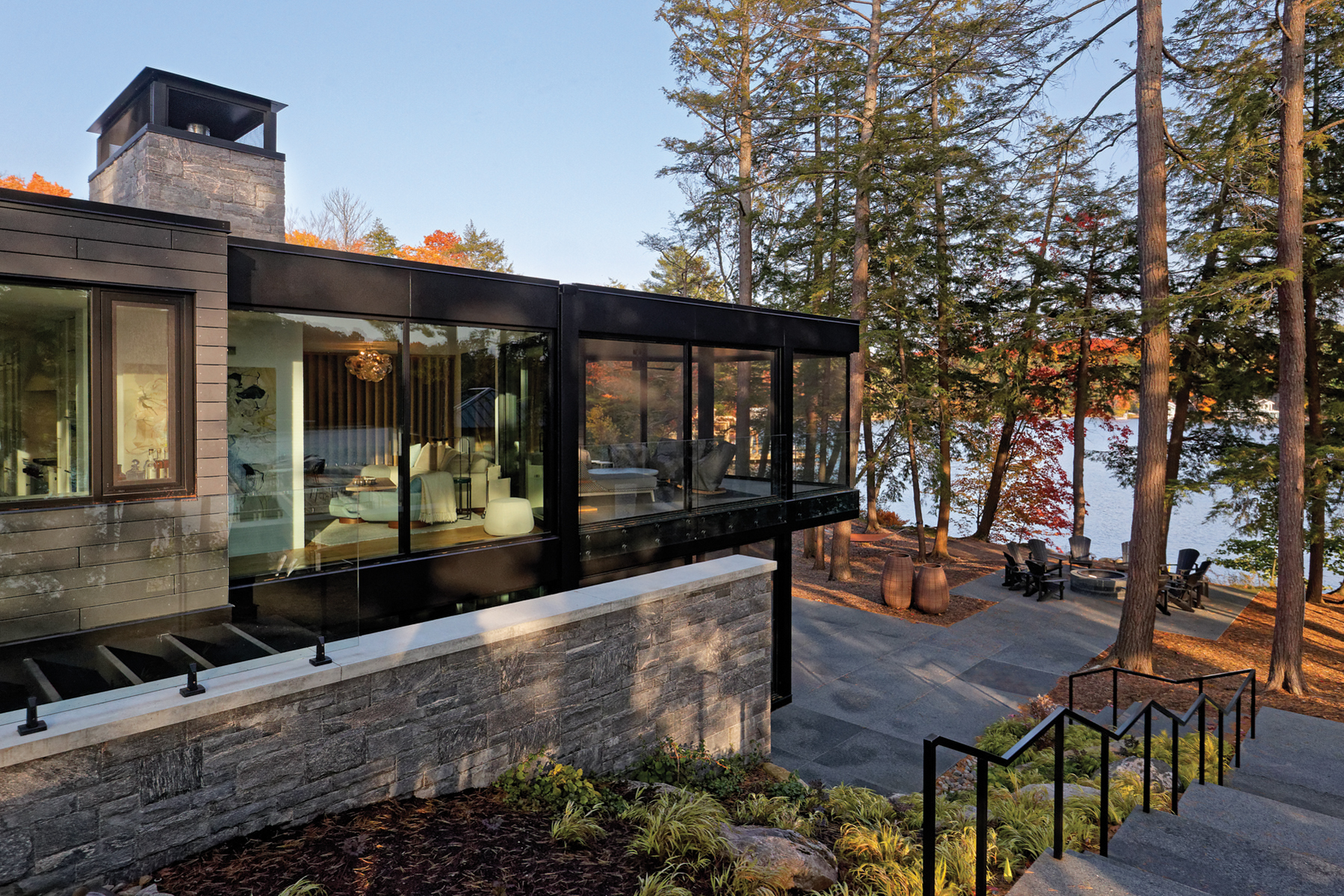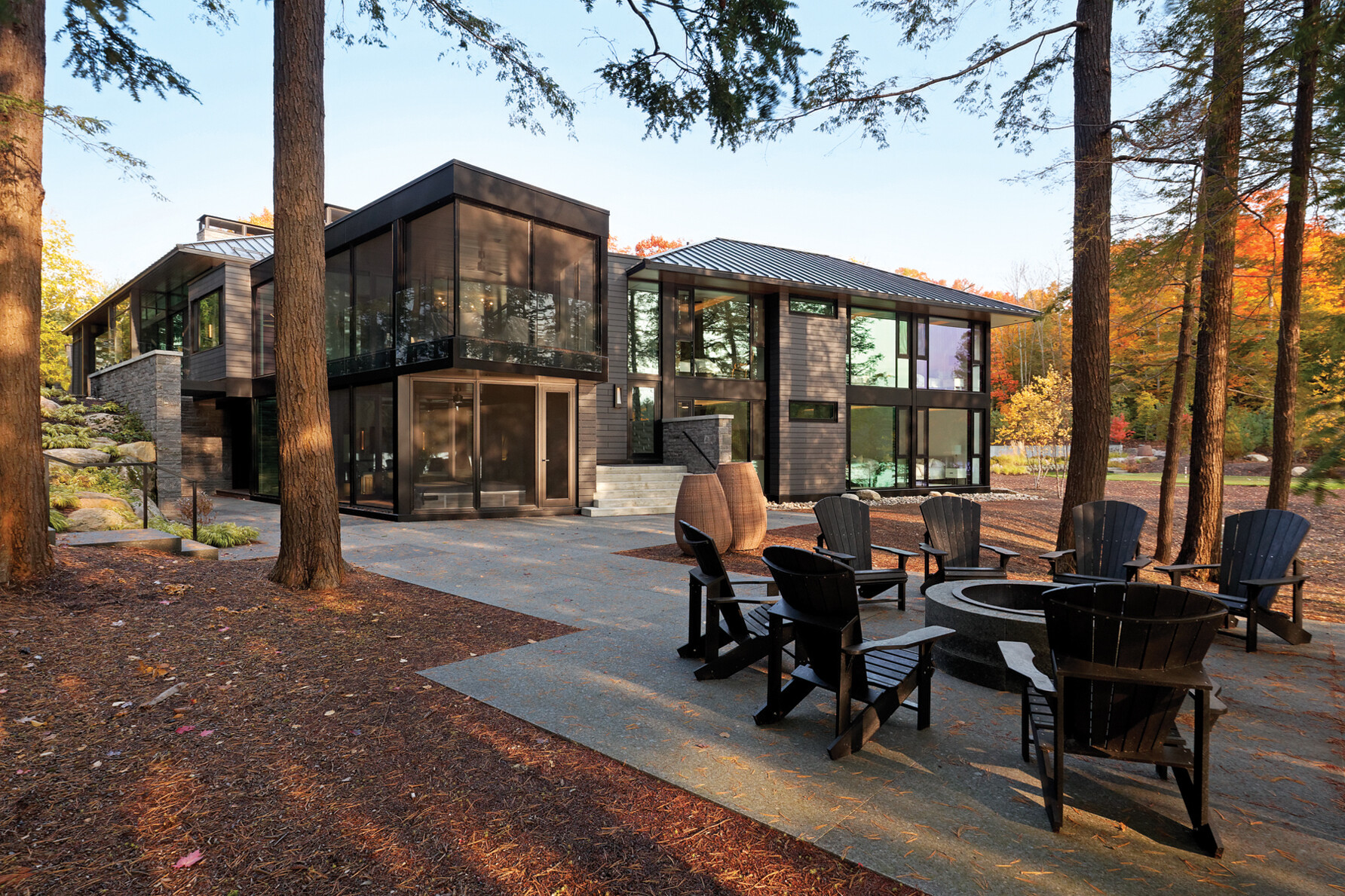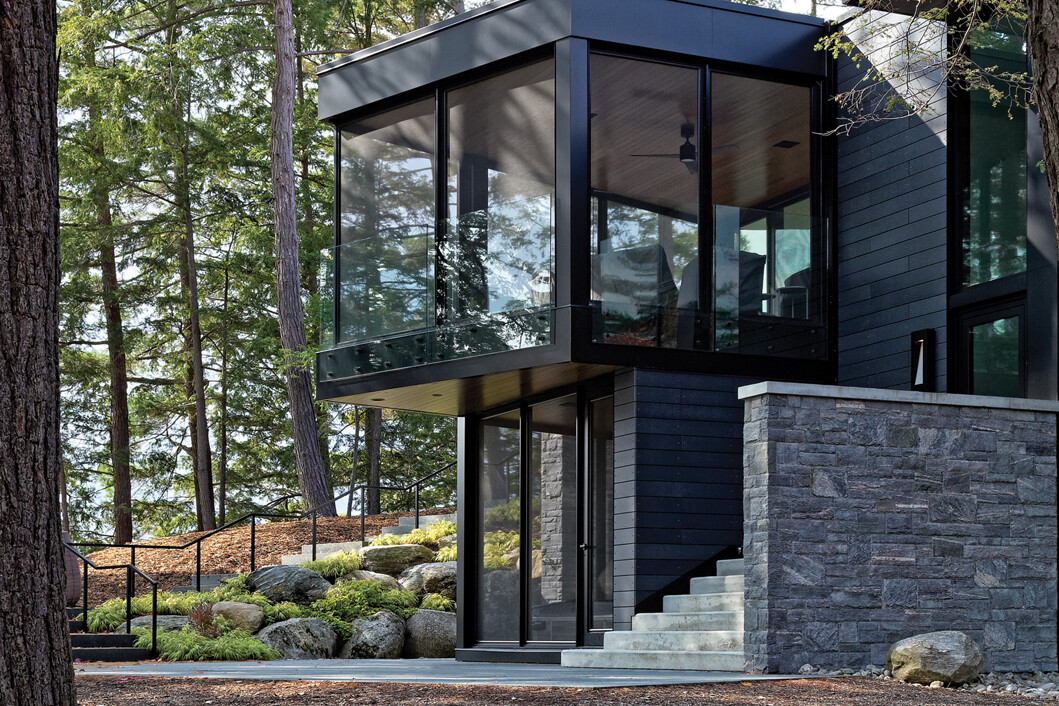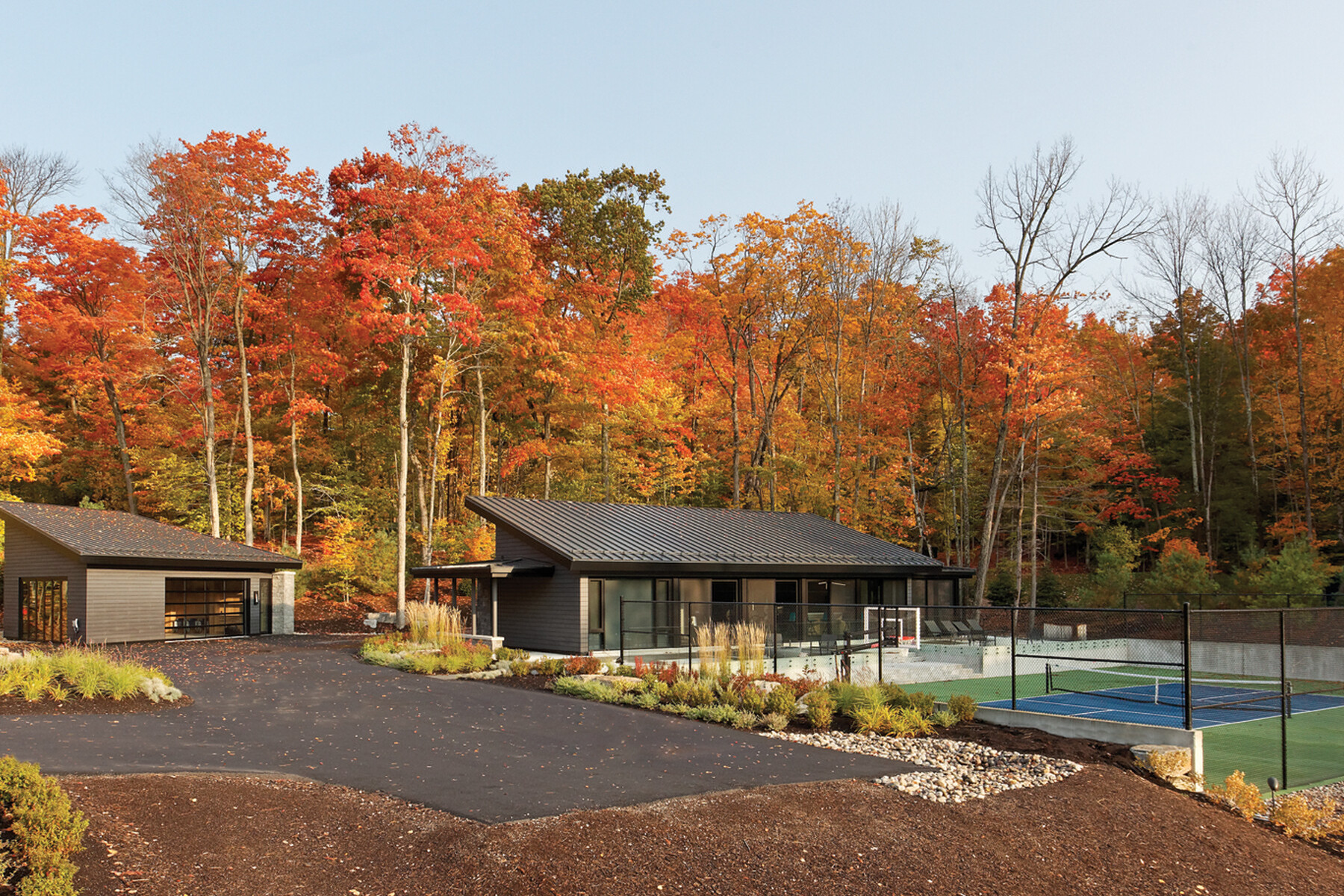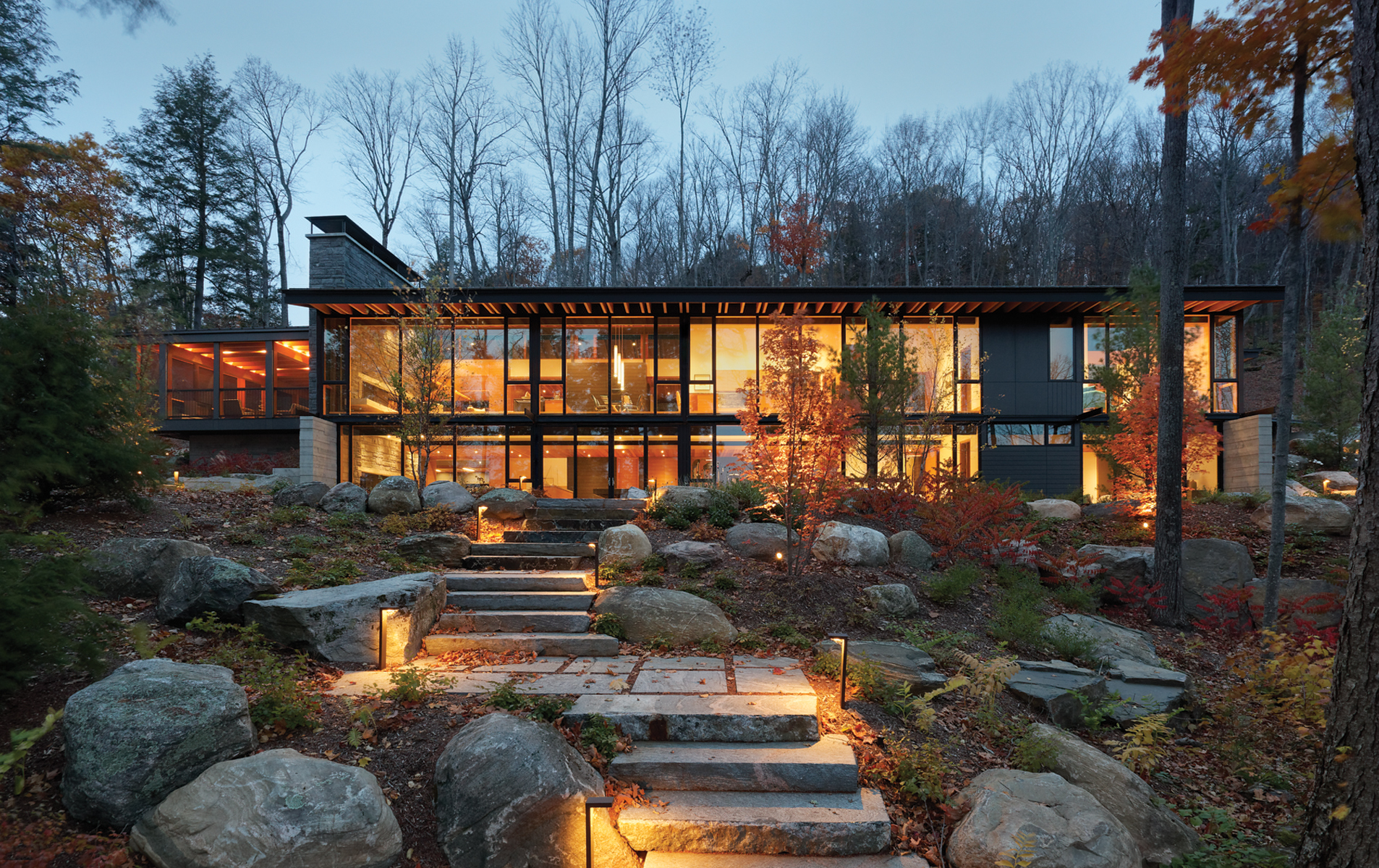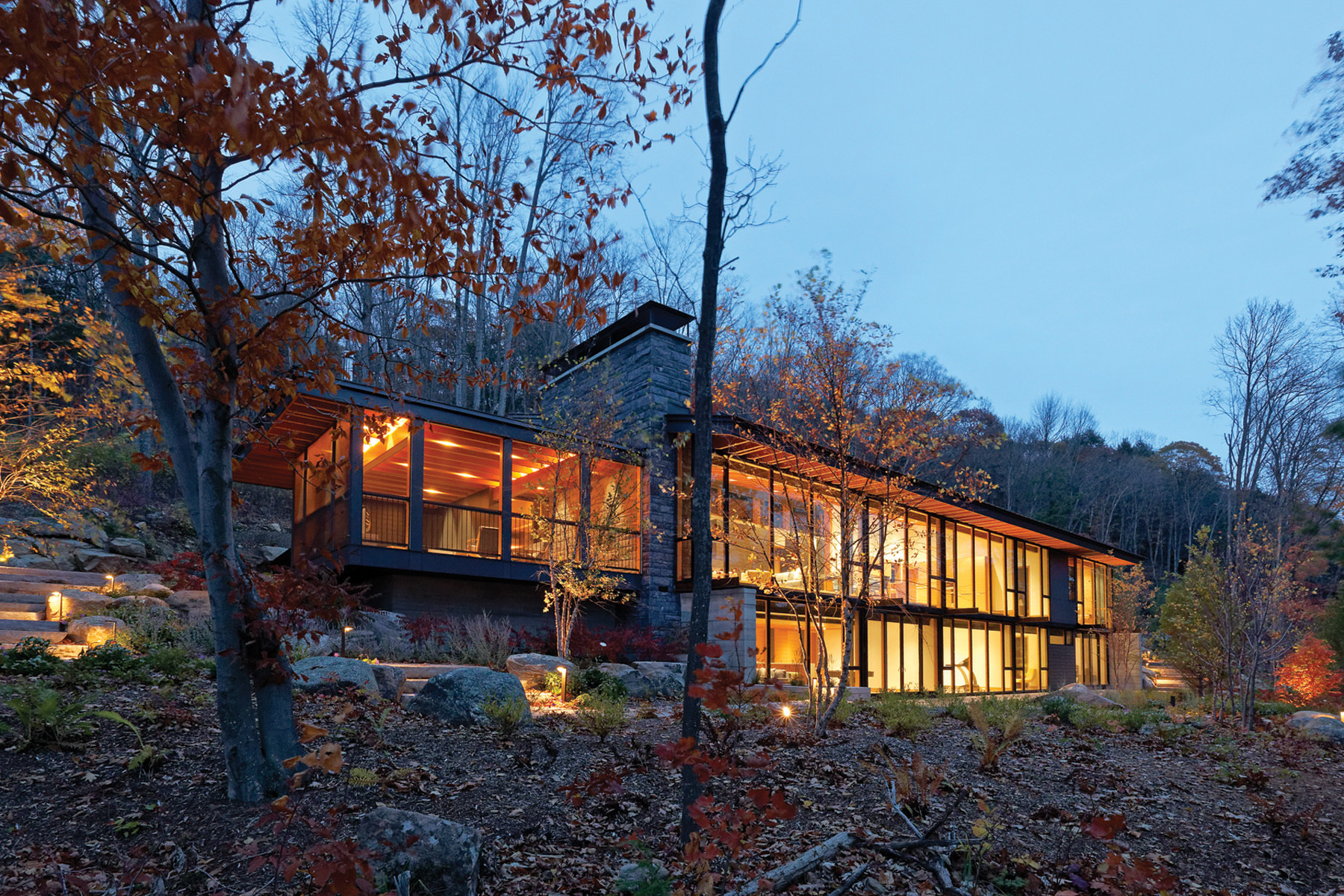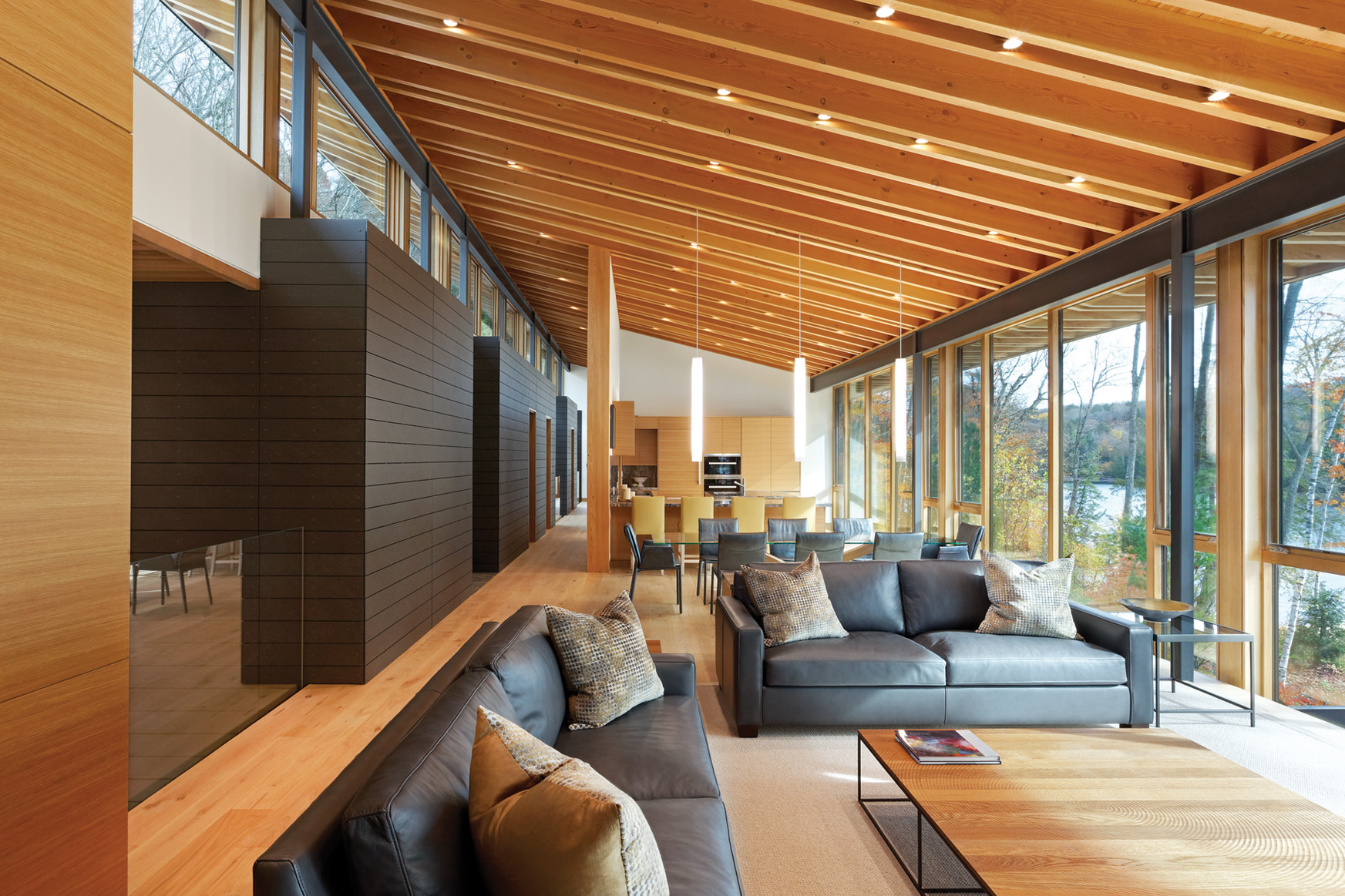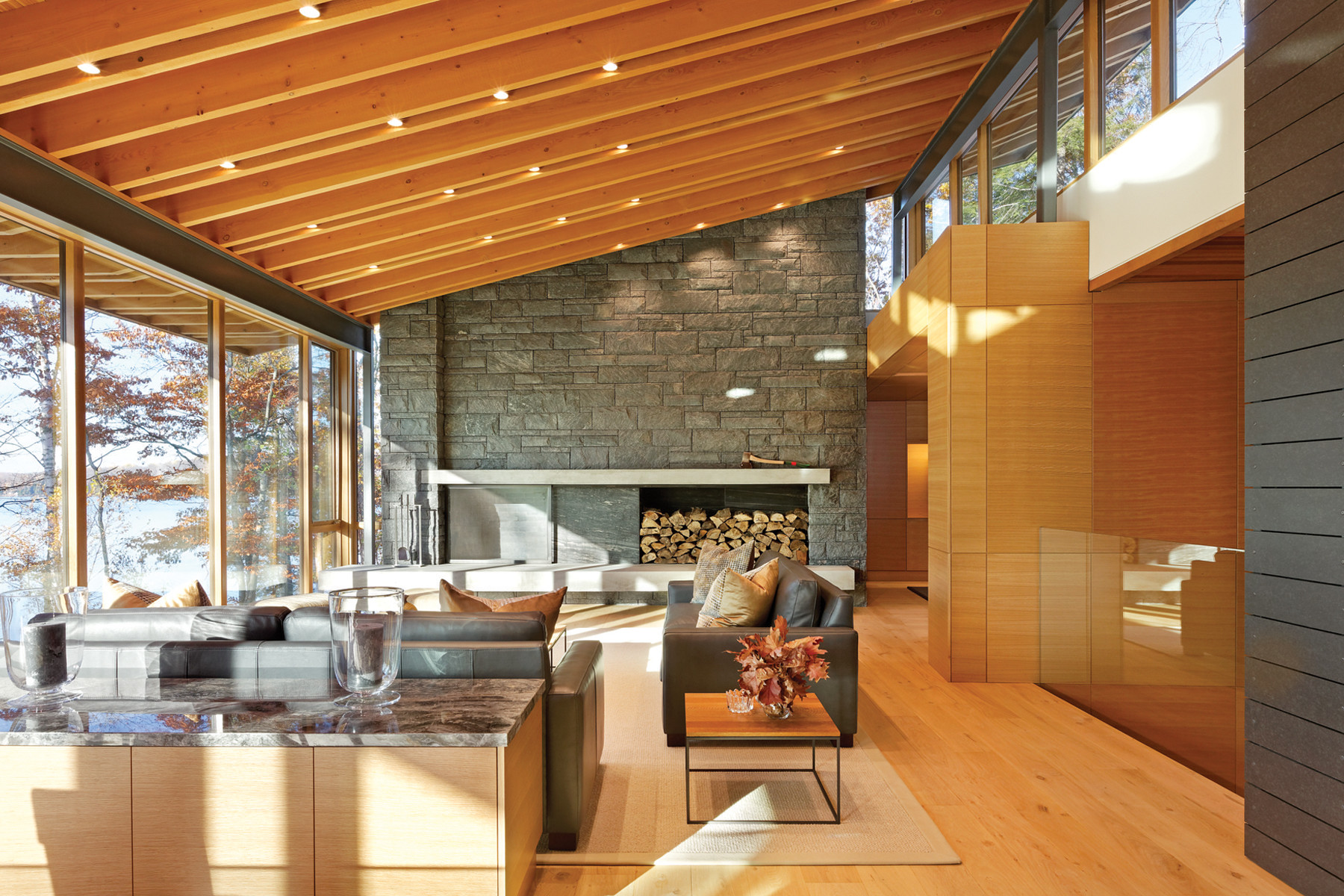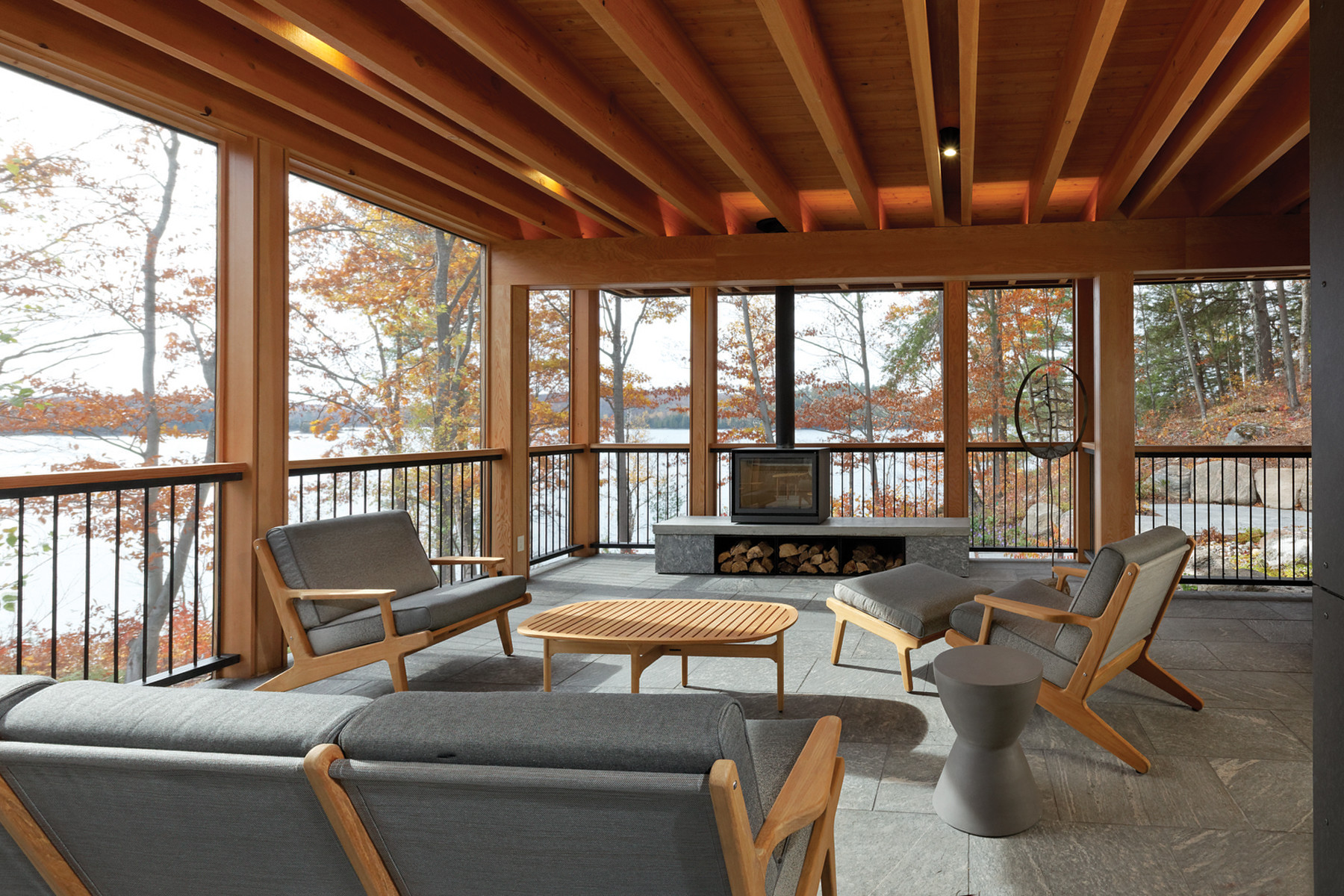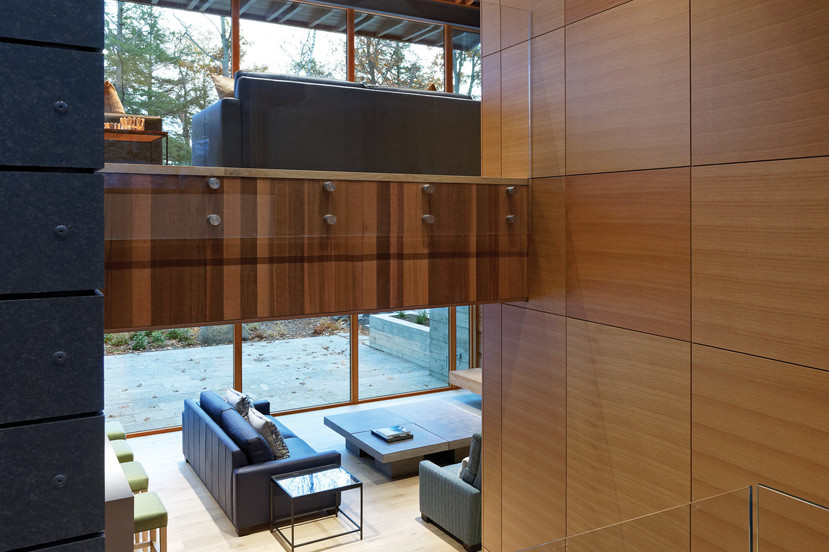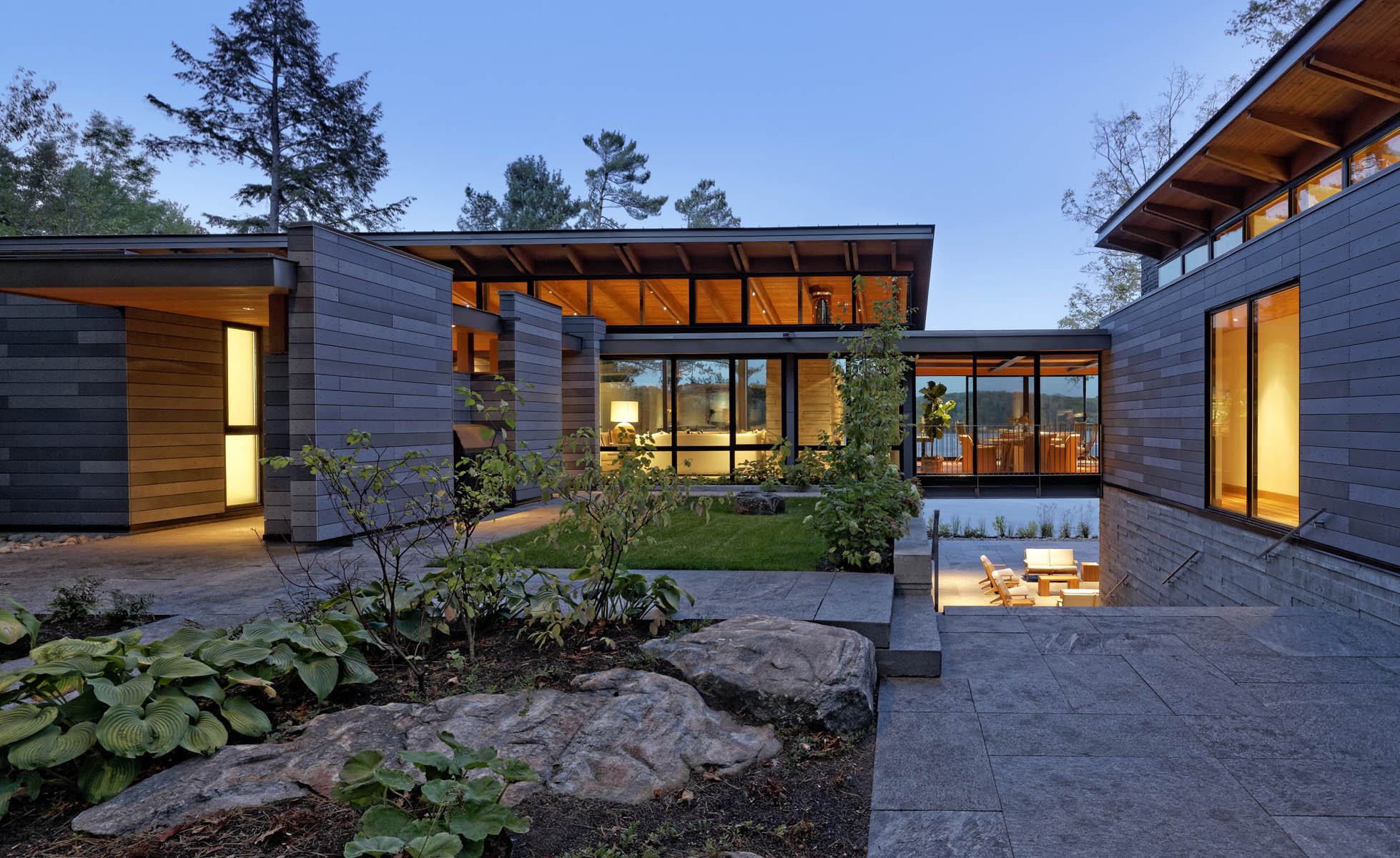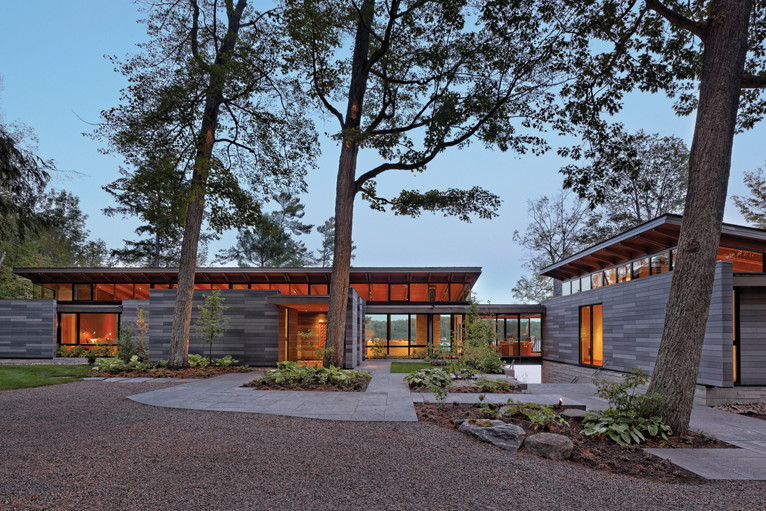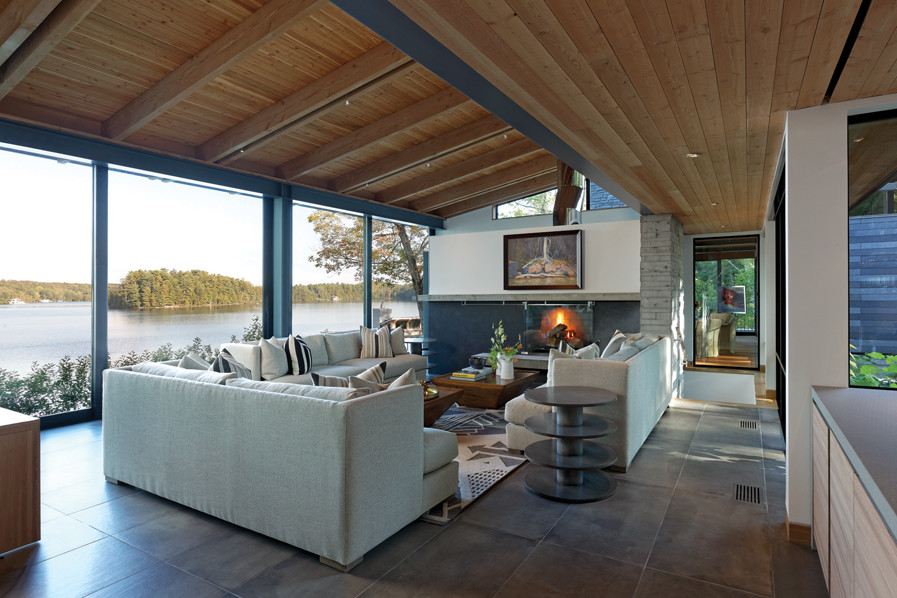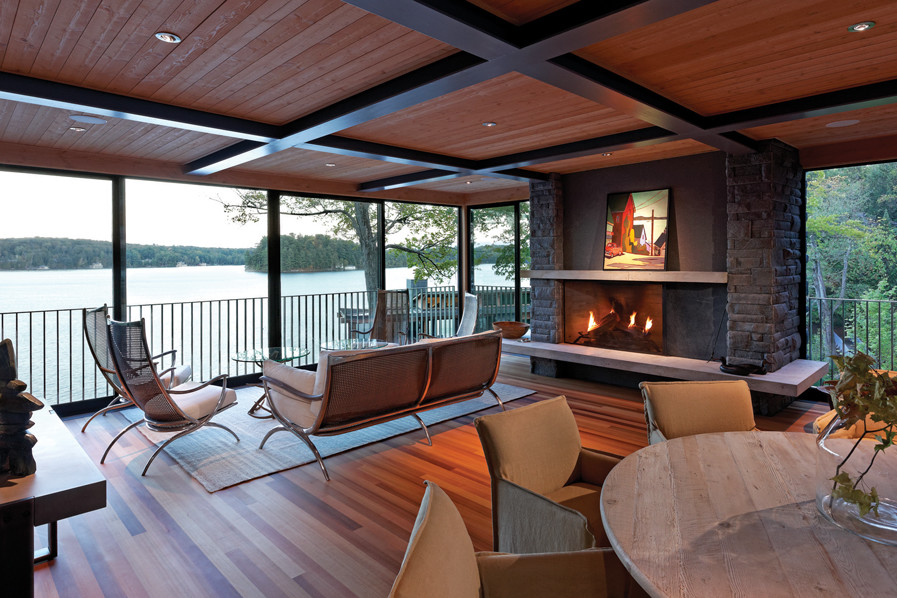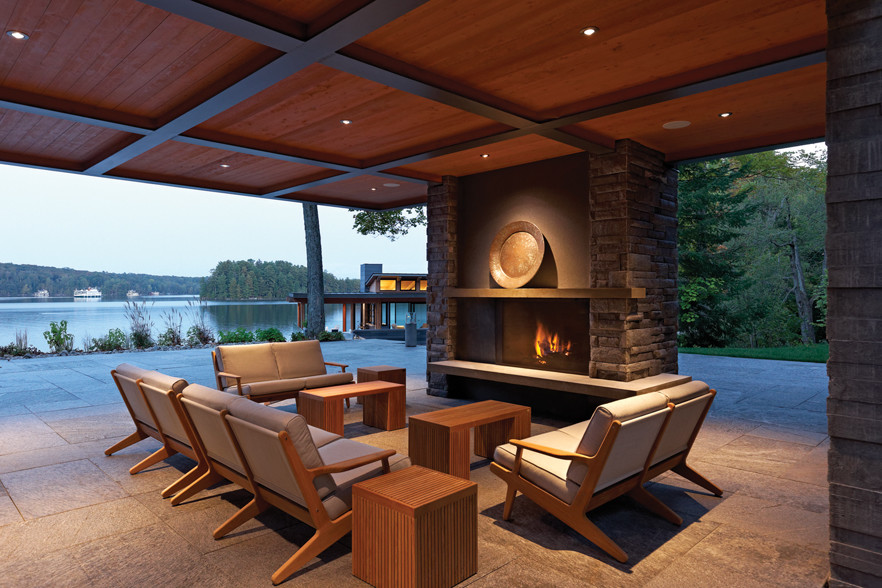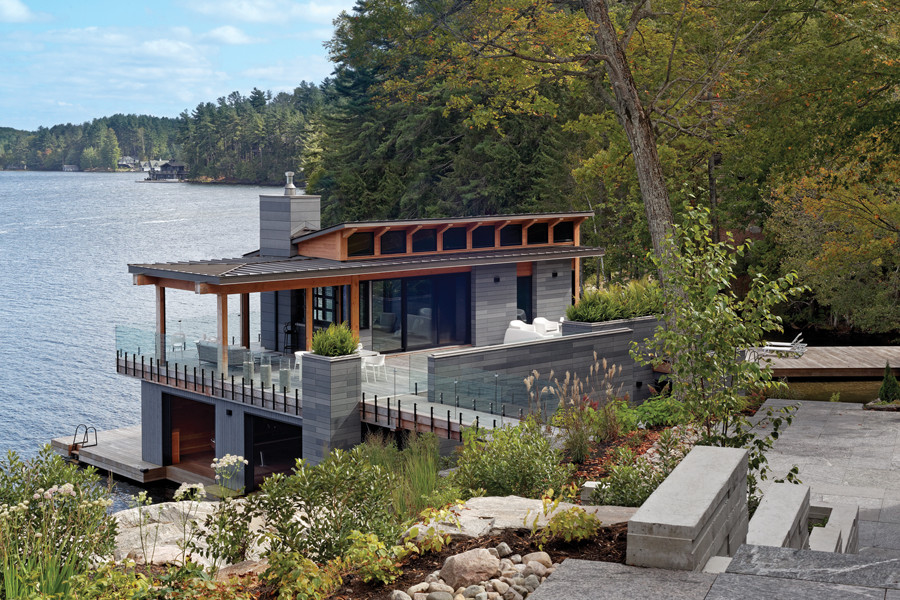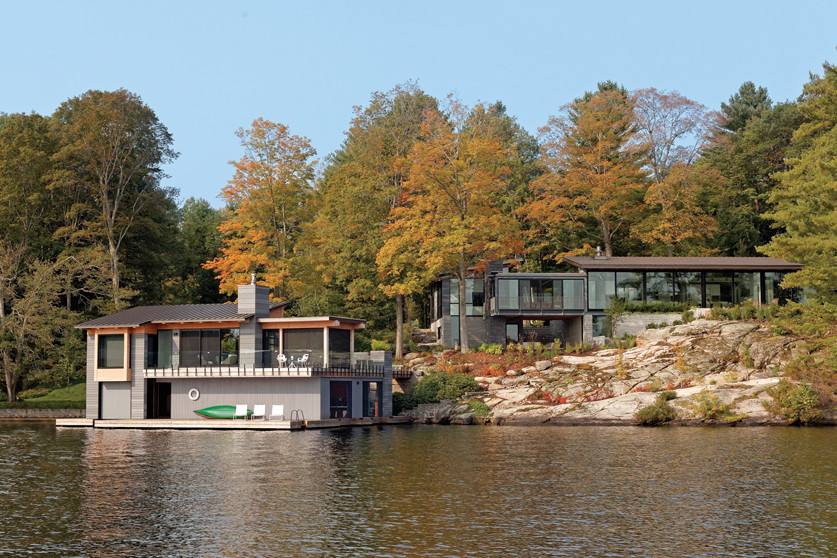St. Francis of Assisi
Originally designed by Arthur William Homes in 1914, the construction of St. Francis of Assisi was completed in 1915.
Located in the heart of Little Italy, the church accommodates 900 people. The Nave, composed of a sequence of vaulted ceilings, allows daylight to come in through the stained glass windows, generating an array of colours as you navigate the space.
As part of the intervention, a new slate roof was installed and the plaster ceiling was completely restored. The interior paint scheme was restored to a monochromatic paint scheme from 1945 to allow the colours from the stained glass windows to be magnified within the Nave. The decoration intensifies in the Transepts and into the Sanctuary to emphasize the importance of that sacred space and the beauty of the East stained glass window. The entire Sanctuary area was restored to its original design with the reconstruction of the wood reredos screen as the backdrop of the Altar and the removal of the mosaic wall installed in 1972 during a previous intervention that concealed the East wall. The East stained glass window was reinstated to its original glory and two Guido Nincheri frescos were unveiled and restored along with all the East wall artwork. The restoration of the coffered ceiling artwork over the Sanctuary was donated by a parishioner of the Italian community in memory of his late wife, proving this project to be essential to the community and possessing immense value to its parishioners.
LOCATION
Toronto, Ontario
DESIGNATED
Ontario Heritage Listed Building
COMPLETED
2018
SIZE
11,530 ft²
SERVICES
Restoration
St. John's Chapel Atrium, St. Michael's Cathedral
The St. John’s Chapel Atrium is +VG’s contemporary addition to the complex of heritage buildings from different eras, which together, make up the St. Michael’s Cathedral site.
Above grade, the Atrium is a modern multipurpose space, creating a cloister-like link between the 1890s Chapel, the administrative and residential accommodation of the 1845 Rectory, and the early 20th Century Sacristies – the ancillary spaces serving the main worship space of the Cathedral Nave. On the exterior, the palette of materials has been carefully chosen to complement that of the existing buildings and maintain the continuity between the different eras represented on site. The interior is simple and reverent, with fair-faced concrete block, wood and slate providing a backdrop to the conserved west façade of St. John’s Chapel and a stained-glass window, relocated from its original home in the Cathedral’s Narthex, which are highlighted as the main visual features of the space. The west façade opens out through tall glazed doors onto a summer terrace under a glass canopy, creating a transitional space between the Atrium interior and the quiet gardens of the Rectory.
Below grade, the Atrium addition contains a new 3,000 ft² basement housing a state-of-the-art Central Utilities plant, providing modern heating, cooling and power systems which have been discretely distributed and integrated throughout the whole complex. This coordination and integration of services has been a key part of +VG’s work at St. Michael’s Cathedral, maintaining the character-defining qualities of the existing heritage buildings, while providing them with the environmental control and high-tech infrastructure of a modern facility, all of which must have been unthinkable at the time the Cathedral was originally built.
LOCATION
Toronto, Ontario
COMPLETED
2018
SIZE
4,800 ft²
SERVICES
Renovation & Addition
House on Viewpoint Trail
This house is situated on a spectacular west facing point on Lake Muskoka.
The existing property had a small cabin on the point which was replaced with a new cottage oriented parallel along the point with views to the north, south and west. The great room has glass on both sides to capitalize on the view in both directions, and is terminated at the end by a fireplace, behind which is a west facing screened porch. The great room includes a large central kitchen and a dining room bay which faces the lake to the northwest.
A large entry hall, powder room and pantry are centrally located near the entrance and behind the kitchen to accommodate the functions of a large family cottage and storage of bulk food supplies.
The layout of the bedroom wing has a central corridor that accesses bedrooms on both sides, allowing all six bedrooms lake views to the north and south. A large, vaulted skylight in the corridor serves to mitigate its length, this skylight along with a small courtyard at the end provides ample daylight throughout the corridor. Several bedrooms have been designed for family members with special needs and are fully accessible. The primary suite is fully glazed at the end of the bedroom wing and has spectacular views out to the lake.
A new three slip boathouse is located on the south side of the point which provides shelter for boat access and a protected area for sunbathers. A one-bedroom suite is located on the second floor with a large deck facing south.
The cottage is designed to be barely visible from the water and is carefully integrated into the existing landscape with minimal removal of the existing tree cover.
LOCATION
Lake Muskoka, Ontario
COMPLETED
2023
SIZE
4,336 ft²
SERVICES
New Construction
House on Jack Lake
The site included an existing seasonal cottage that had been built in the early 1980s. The building was now showing its age and was due for either replacement or major renovations.
The new owners have a cottage on the mainland and had long admired the site as a potential gathering place for family and friends and wanted to preserve its natural character. The site has no power, so the decision was to build a small off-grid pavilion and boathouse to use on summer weekends for picnics and camping.
The new pavilion houses one bedroom and a gathering room with fireplace; there is an additional outbuilding spa with bathroom and shower. The boathouse has two slips and one open space on the second floor for recreation or sleeping.
The pavilion was designed to have a minimum impact on the site and to not be visible from the water. This was achieved by removing as few trees as possible and integrating the building into the sloping landscape. The main gathering space is glass enclosed with sliding doors that open at the corners to maximize the connection with the outdoors and deconstruct the envelope of the building when opened.
Exterior materials include Parklex Prodema siding, and a zinc roof with metal clad windows for minimal maintenance.
The entire building is powered by solar panels and a battery array which can support limited use indefinitely and is completely off-grid.
LOCATION
Kawartha Lakes, Ontario
COMPLETED
2023
SIZE
5,550 ft² (Cottage) + 675 ft² (Guest Suite above Garage)
SERVICES
Renovation/Demolition & Addition
House on Blueberry Island
Blueberry Island is at the north end of Lake Joseph and has, until recently, remained vacant. The island has long been a destination for picknickers in Muskoka with the tacit permission of the out of province owners.
The new owners have a cottage on the mainland and had long admired the site as a potential gathering place for family and friends and wanted to preserve its natural character. The site has no power, so the decision was to build a small off-grid pavilion and boathouse to use on summer weekends for picnics and camping.
The new pavilion houses one bedroom and a gathering room with fireplace; there is an additional outbuilding spa with bathroom and shower. The boathouse has two slips and one open space on the second floor for recreation or sleeping.
The pavilion was designed to have a minimum impact on the site and to not be visible from the water. This was achieved by removing as few trees as possible and integrating the building into the sloping landscape. The main gathering space is glass enclosed with sliding doors that open at the corners to maximize the connection with the outdoors and deconstruct the envelope of the building when opened.
Exterior materials include Parklex Prodema siding, and a zinc roof with metal clad windows for minimal maintenance.
The entire building is powered by solar panels and a battery array which can support limited use indefinitely and is completely off-grid.
LOCATION
Lake Joseph, Muskoka, Ontario
COMPLETED
2023
SIZE
1,700 ft²
SERVICES
New Construction
PHOTOGRAPHY
David Whittaker
House on Cumberland Bay
The owners have had extensive experience cottaging in Muskoka. They sold their cottage on Lake Muskoka and purchased the new property which had become vacant, save for a newly completed boathouse on the shoreline.
The site posed challenges as the topography at the proposed building site sloped steeply up from the shoreline to a ridge. The zoning setbacks restricted the constructable area to a zone behind the lakeside ridge. The proposed design would need to address this so that the main level would have a view of the water below.
The design solution was to create a basement level for storage below the main living area by raising the main floor above the ridge and concealing the basement. The building follows the shoreline and creates an ‘L’ shaped plan with bedrooms at opposite ends of the great room and other living spaces. The primary suite at one end is separated from the rest of the bedrooms and includes an ensuite bathroom, closet, and private screened porch. The bedroom wing at the opposite end is two storeys, taking advantage of the topography which falls away along this wing. At the angle between the two wings on the main floor is a family room and staircase which connects the upper and lower levels. Beneath the family room is a multi-purpose storage area with a hot tub and sitting area below the screened porch and adjacent through the outdoor underpass.
The outdoor underpass connects the entry side with the lakeside and the rooms above form a bridge over it. This walkway provides access to a storage area below the great room and a hot tub spa on the adjacent side while providing lake access from the parking area.
The building program also included a large sports pavilion, sports court and garage that can double as an indoor basketball half-court in inclement weather. These out-buildings frame the approach to the cottage upon entry to the site.
LOCATION
Cumberland Bay, Muskoka, Ontario
COMPLETED
2023
SIZE
7,000 ft²
SERVICES
New Construction
House on Haliburton Lake
This house, located in a remote part of Haliburton, is built into the site which slopes toward the lake.
The long narrow design of the footprint allows most principal rooms a view of the lake while integrating the building into the hillside without creating an extremely high building on the lake side. In contrast, the games room and entertainment area are designed to be more enclosed, to create a more “cocooned” atmosphere as opposed to the open daylit spaces on the view side. The design integrates the interior and exterior using floor to ceiling and wall to wall glass, opening clerestorey windows and by making indoor materials continuous with outdoor materials. Lighting is integrated into the Douglas fir ceiling rafters, and the cadence and pattern rafters of the spacing results in an animated ceiling reminiscent of the tree canopy.
One feels as if they are part of the outside, sheltered between “pavilions” under one roof. The entrance procession leads guests passed light wells broken up by two-storey forms that restrain the interior corridor from the exterior window, allowing sky views from the lower level. These forms serve programmatic function while physically bringing the materiality of the exterior inside and spatially linking the differing grades on either side of the building. These objects march beyond the threshold of the front door revealing a two-storey wood cube at its conclusion. Entering the insular wood cube provides a warm nook which turns inward from the mostly open floor plan. The route down the stairs between the gateway created by these formal objects will complete the journey towards the lake.
A screened porch is located strategically behind the living room fireplace as opposed to obstructing views from the great room, and commands views to the south and west of the lake.
LOCATION
Haliburton, Ontario
COMPLETED
2019
SIZE
7,742 ft²
SERVICES
New Construction
PRESS
Turning typical lake home design on its side
Toronto Star
A Tangible Connection: House on Haliburton Lake
Canadian Interiors
Bridge House
Located in Muskoka, Ontario, the Bridge House overlooks the south end of Lake Joseph, one of three large lakes in the region.
The house is located on a rock outcrop overlooking the lake and the boathouse, and breaks the mould of faux-traditional architecture typical of the region.
The building is L-shaped in plan, with the main living space and master bedroom wing separated from the guest bedroom wing by an elevated screened porch. The plan of the main living wing was developed to create circulation along either side of the plan to maximize openness, views, and transparency.
The L-Shaped floor plan hugs the curved crest of the hill. The building emerges from the rock face defining an edge and creating a gateway, an arrival from the water that emphasizes the boundary between the hectic city environment and the serenity of the lakeside location. The screened porch forms a “Bridge” which spans the space between the two wings, creating a threshold between the driveway and the lake. The building appears to be a part of its site, merging with the rock overlooking the lake.
LOCATION
Muskoka, Ontario
COMPLETED
2017
SIZE
6,338 ft²
SERVICES
New Construction
PRESS
Toronto architect: Schools going forward will be ‘wellness hubs’
Toronto Sun
A perfectly framed Muskoka cottage, from the inside and outside
Globe and Mail

